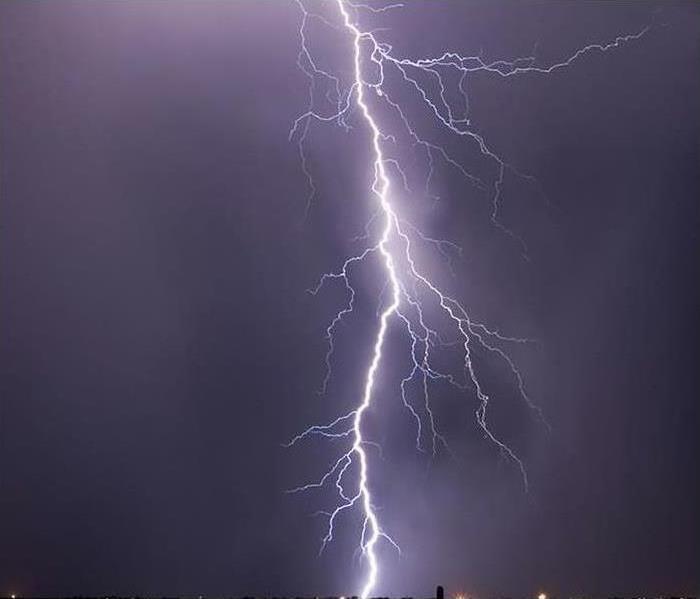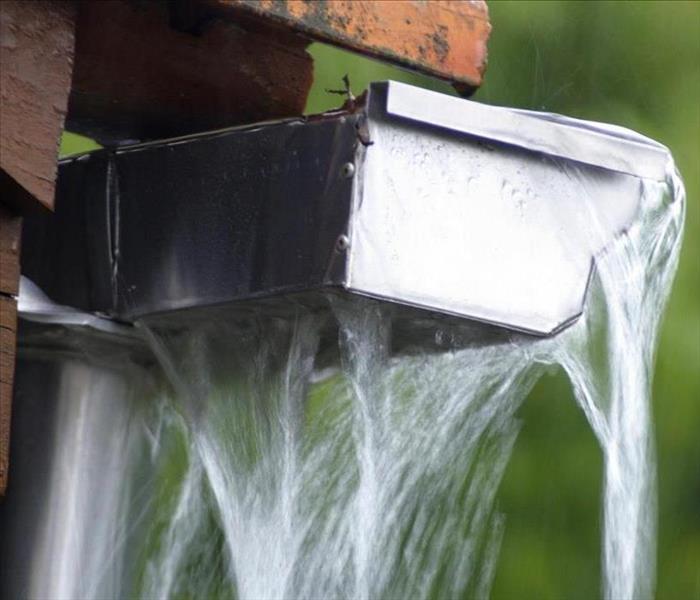Archived Storm Damage Blog Posts
Storm Preparation
10/29/2024 (Permalink)
1. Stay informed. Being prepared means first and foremost to know what kind of weather is on the way. The National Weather Service provides a map of the U.S. with the latest warnings; simply click on your location to get more detailed information. Of course, you can also listen to your local weather forecast or use a weather app. In addition, keep your phone charged and on, as that will allow you to receive local weather alerts such as flood warnings.
2. Don’t leave vehicles and other expensive items outdoors. Cars, motorcycles, outdoor furniture, and even children’s playground toys, can easily get damaged due to high winds. They can also blow away and cause damage to your home. Place your vehicles in your garage or carport and put the outdoor furniture and toys inside your home or in a shed.
3. Prepare your yard. Trees, plants, and shrubs take quite a beating during storms. Most will recover by themselves, but you’re best advised to take certain precautions. If you have any plants in pots, bring them indoors to prevent them from being blown over. You should also prune back any tree branches that are close to your home and cut down dead or dying trees.
4. Install storm shutters. During high winds, your windows are vulnerable to branches and other debris blowing around. You can protect them by installing storm shutters. Make sure the shutters are properly secured before the storm starts. If you don’t have enough time to install storm shutters, you can also protect your windows by affixing sheets of plywood in front of them.
5. Clean out the gutters and storm drains. Storms can bring a lot of precipitation. Your gutters are intended to lead that water safely away from your home so it doesn’t collect and cause water damage. Check them thoroughly paying particular attention to the joints and downspouts where buildup can occur. You should also make sure your storm drains are free of leaves and other debris so water doesn't pool there.
6. Check your generator. If you rely on a generator during power outages, then you need to make sure it’s in good working order before the storm starts. Do a manual test to make sure it runs properly. In addition, make sure you have sufficient fuel to last for a few days.
7. Create an emergency kit. Your emergency kit should include at the minimum items such as bottled water, a flashlight, a first aid kit, non-perishable food, blankets, and warm clothing, phone chargers and batteries, and a radio. You should also consider placing copies of important documents such as passports, insurance policies, and medical records in your kit.
Water Damage Services
10/29/2024 (Permalink)
Chicago is called the "windy city" but sometimes it feels like it should be called the "city of flooded basements." Over the past few years, there has been an increase of flooding in the Chicago area and that's worth paying attention to.
When it comes to water damage, it can cost you more if you ignore it. Most homeowners and business owners only think of the costs of replacing products, equipment and personal property. But what about those other costs? You also have to consider costs that you might pay such as rent, loans, wages, etc. Not to mention your business would lose operating profit from not being open and the inconvenience of having to relocate.
SERVPRO of Kendall County specializes in water mitigation and restoration services. We have completed numerous restoration projects in the Oswego area. Our technicians are thoroughly trained both on-site as well as classroom instruction on restoration best practices.
Here are a few of the water damage restoration services we provide:
- Water removal
- Cleanup
- Damage restoration
- Clothing restoration
- Electronics repair
- Deodorization and carpet cleaning
- Photo documentation of the site
- Insurance coordination
Storm Preparations
10/11/2024 (Permalink)
Facts about Thunderstorms
- They may occur individually, in clusters or in lines.
- Some of the most severe occur when a single thunderstorm affects one location for an extended time.
- Thunderstorms typically produce heavy rain for a brief period, anywhere from 30 minutes to an hour.
- Warm, humid conditions are highly favorable for thunderstorm development.
- About 10 percent of thunderstorms are classified as severe – one that produces hail at least an inch or larger in diameter, has winds of 58 miles per hour or higher or produces a tornado
Facts about Lightning
- Lightning’s unpredictability increases the risk to individuals and property.
- Lightning often strikes outside of heavy rain and may occur as far as 10 miles away from any rainfall.
- “Heat lightning” is actually lightning from a thunderstorm too far away from thunder to be heard. However, the storm may be moving in your direction.
- Most lightning deaths and injuries occur when people are caught outdoors in the summer months during the afternoon and evening.
- Your chances of being struck by lightning are estimated to be 1 in 600,000 but could be reduced even further by following safety precautions.
- Lightning strike victims carry no electrical charge and should be attended to immediately.
Know the Terms
Familiarize yourself with these terms to help identify a thunderstorm hazard:
Severe Thunderstorm Warning- Issued when severe weather has been reported by spotters or indicated by radar. Warnings indicate imminent danger to life and property to those in the path of the storm.
Severe Thunderstorm Watch- Tells you when and where severe thunderstorms are likely to occur. Watch the sky and stay tuned to NOAA Weather Radio, commercial radio or television for information.
What to Do If a Tree Falls on Your House
10/6/2023 (Permalink)
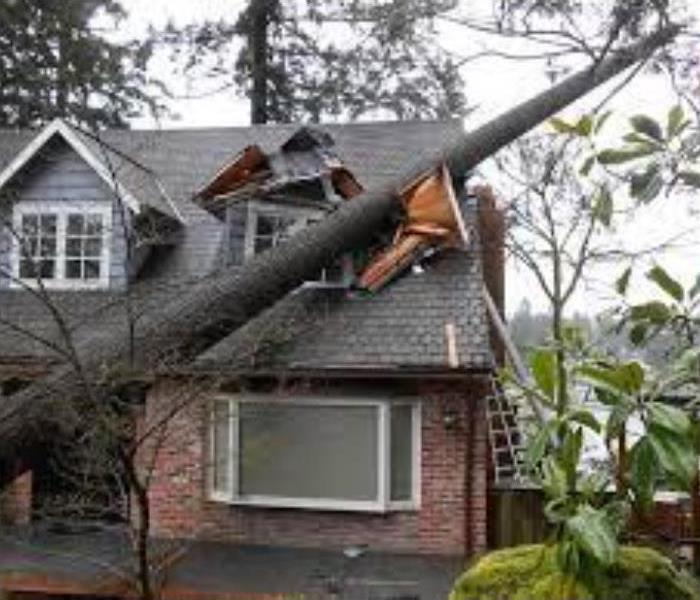 If you’re a homeowner with large trees on or near your property, it’s important to know what to do if one hits your house.
If you’re a homeowner with large trees on or near your property, it’s important to know what to do if one hits your house.
Older neighborhoods can be a joy to live in. Beautiful architecture, friendly neighbors, good schools, and big trees. Unfortunately, sometimes those big trees can be a disadvantage too. Especially if one falls and blocks access to the street, takes down electrical wires or, even worse, lands on your house. So, if you’re a homeowner with large trees on or near your property, it’s important to know what to do if one hits your house.
Why Do Trees Fall?
The two most common reason trees fall are root damage and weather. Trees whose roots have been weakened by root rot, or damaged by construction or ground compaction, can become unstable—especially in the summer months when the canopy is heavy with leaves and the soil may loosen as a result of heavy rain. In some cases, the tree may have shallow roots due to compacted soil or because it’s normal for that tree species. But even a tree with healthy roots can fall because of a combination of saturated ground and high winds or lightning. The worst-case scenario is a hurricane or tornado, but trees can also fall after several days of rain combined with straight-line winds. Keeping your trees’ roots healthy can prevent most disasters, but not all. So, what should you do if the worst happens?
Evacuate the House
If a tree or one of its large limbs crashes through the roof, first make sure all the occupants are safe. Check in with everyone—including your pets—then get out of the house as quickly and safely as possible. Make sure you have a “go bag” prepared or you take items you’ll need like cash, car keys, important documents and, if possible, a change of clothes. Once you know everyone is safe, call 911 so the fire department can help you secure your premises. Although it may be tempting, make sure you:
Don’t climb onto your roof.
Don’t climb onto the fallen tree.
Don’t touch downed power lines.
Preparing Your Home for Severe Weather
10/4/2022 (Permalink)
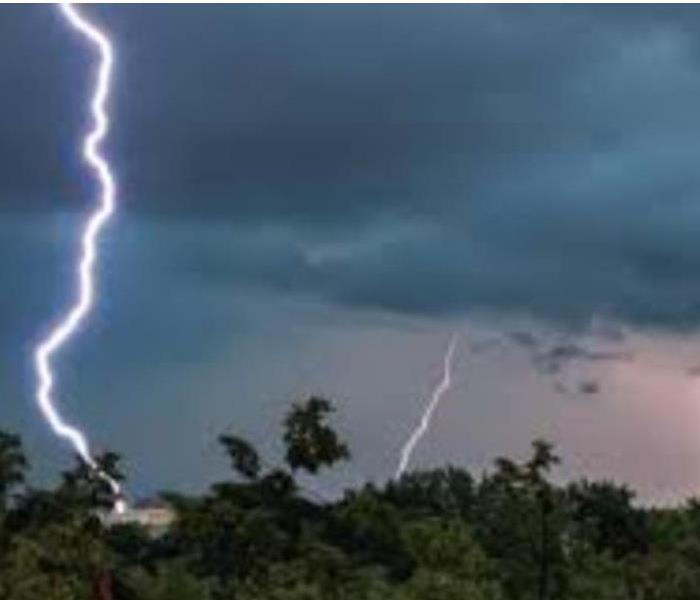 Follow these safety measures and general tips to help you weather the storm.
Follow these safety measures and general tips to help you weather the storm.
Preparing for a Tornado
Every state has at least minimal risk for tornadoes, though the region spanning from South Dakota to Texas is nicknamed Tornado Alley for a reason. Tornado season spans the spring and summer seasons.
Before a tornado hits, follow these severe weather tips:
- Look outside for approaching storms and remain on alert for signs of a tornado, such as a dark sky, large hail, low-lying or fast-moving clouds, or roaring sounds.
- Listen to your NOAA Weather Radio, commercial radio or TV newscasts to remain informed. Follow the instructions given by local emergency officials.
- Recognize emergency alerts during a storm. A tornado watch means a tornado is possible. A tornado warning means a funnel has been spotted.
- If a tornado warning is issued, take shelter in the basement or storm cellar immediately. If your home doesn’t have an underground room, an interior bathroom is the best place to hunker down.
Preparing for a Hurricane
The Atlantic and Gulf of Mexico coastal regions are at risk for hurricanes. The Southwestern US can also experience heavy rains and floods from hurricanes generated off the coast of Mexico. Hurricane season lasts from June to November.
Before a hurricane hits, follow these severe weather tips:
- Learn the elevation of your property to understand your personal flood risk. Determine whether levees and dams in your area could affect you if they break.
- Become familiar with areas of higher ground in your city and determine how you would get there during an emergency.
- Make plans to secure your home, including covering windows with storm shutters or plywood; installing straps to fasten your roof to the frame structure; and reinforcing garage doors.
- Make plans to prepare your property, such as bringing un-tethered outdoor objects inside; trimming back trees and shrubs for better wind resistance; and determining how to secure your boat.
- Recognize emergency alerts during a storm. A hurricane warning means unrelenting winds of 74 miles per hour or higher are expected to create hurricane conditions within the next 36 hours. A hurricane watch is similar, but the alert is issued within 48 hours of the anticipated storm.
Preparing for a Thunderstorm
Thunderstorms are dangerous because they always produce lightning and may produce hail, strong winds, flash flooding, tornadoes and wildfires if lightning strikes the ground. Thunderstorms can occur anywhere in the US and are most likely during the summer.
Before a thunderstorm hits, follow these severe weather tips:
- Prepare your home by shuttering windows and doors, and unplugging sensitive electronics.
- Prepare your property by removing damaged tree branches that could fall during a storm, and bringing outdoor objects inside.
- Watch the sky and tune in to your NOAA Weather Radio for information.
- Recognize emergency alerts during a storm. A severe thunderstorm watch means stormy conditions are likely to occur. A severe thunderstorm warning means radar indicates severe conditions exist.
- If a severe thunderstorm warning is issued, danger is imminent. Seek shelter inside or within a hard-topped vehicle if no buildings are nearby.
General Tips
- Build an emergency kit: You need food, water and basic disaster supplies to last 72 hours. Assemble your emergency kit well before severe weather strikes. You may have to evacuate at a moment’s notice, so keep your emergency kit in an easy-to-access place.
- Create a family communication plan: Your family may be scattered around town at school, work and daycare when a storm hits. That’s why you should create a family communication plan now. Establish how you’ll get in touch, reunite and handle different situations. Make sure every family member has their parents’ and siblings’ cell phone numbers memorized.
- Learn your city’s evacuation plan: If you live in a storm-prone area, your community may have established evacuation routes to leave the area safely and quickly. Learn about these plans and share them with your family.
Recovering after a Tornado
9/13/2022 (Permalink)
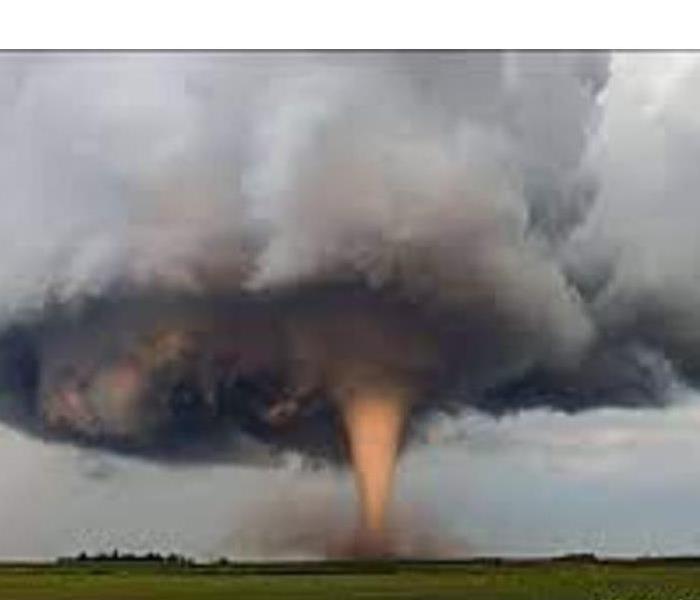 Recovering from any disaster is a gradual process, but the better prepared you are, the easier and faster your recovery can be.
Recovering from any disaster is a gradual process, but the better prepared you are, the easier and faster your recovery can be.
Your post tornado disaster plan should cover many facets…
- Health and safety
- Quickly check for injuries to assess needed attention.
- Do not move the seriously injured unless they’re at risk of immediate danger. Call for help.
- Refer to local news or your weather radio for updated information and instructions, such as shelter, clothing, food and water from FEMA, Red Cross and other volunteer agencies.
- Only return when authorities tell you it’s safe.
- Ensure drinking water is safe. Do not drink, brush teeth, or wash hands or dishes with water until it has been declared safe.
- BOIL: Boil for one minute, then cool, storing in clean, covered containers.
- BLEACH: 1/8 teaspoon or 8 drops of regular, unscented, liquid household bleach per gallon should be used. Let water stand 30 minutes before using.
- Manage food supplies. Throw out any foods that have come in contact with floodwater, including cans and water bottles that appear sealed.
- Do not flush toilets until you know sewer lines are intact and properly functioning.
- Opt for battery powered lighting over candles.
- Keep pets under control.
- Communication
- Use the telephone only for emergency calls.
- Keep a battery-powered radio on hand at all times.
- Travel
- Stay off the streets.
- Only travel when roads have been cleared safe by authorities, or when absolutely necessary.
- Beware of washed out roads, unsafe structures (building, bridges, etc.), downed power lines, chemicals spills, animals, and other health and safety risks.
- Rebuilding
- Never enter a damaged building. When in doubt, consult a qualified building inspector prior to entrance.
- Don’t return to a flood damaged area until it has been cleared as safe by authorities.
- Wear long pants, a long sleeve shirt, and sturdy shoes when surveying for damage.
- If it is safe, turn off all utilities at the source (water, gas, electricity).
- Unplug appliances and let them dry out.
- Watch for damaged power and gas lines – report them to the utility company immediately.
- If you smell gas, immediately vacate the premises and notify the fire department and gas company.
- Quickly address spilled medications, chemicals, and flammable liquids that could pose fire and safety hazards.
- Take photos of damaged structures and contents for insurance claims.
- Set priorities, and do not exhaust yourself.
- When clearing a flooded basement, do so slowly, draining about 1/3 per day, to prevent building collapse.
- When rebuilding, consider adding a tornado safe room. Funding grants may available in your area.
- Keep a good record of cleaning and repair costs for insurance reimbursement.
- Professional help
- SERVPRO of Kendall County is available 24/7
- Strengthen your home’s structure when rebuilding with the appropriate reinforcements such as anchors, clips, straps.
- Use sturdy building materials and the proper structural supports for masonry walls and chimneys.
- Permanently attach your manufactured home to its foundation.
- Have all utilities – electrical, gas, and water – tested for safety before restoring operation.
- Pump out wells and have well water tested for contaminants before drinking.
- Emotional needs
The emotional toll a disaster takes can be more devastating than physical damage and financial difficulties combined. Children and older adults are particularly at risk. Don’t neglect emotional needs. Get help. Contact FEMA, the Red Cross, other volunteer agencies, local churches, or your health insurance company for professional counseling assistance. - Letting everyone know you’re safe.
Register for the American Red Cross Safe and Well program by web site or phone (1-866-GET-INFO) to let family and friends know you're safe. - Familiarize yourself with the American Red Cross Tornado Safety Checklist.
Have a tornado disaster plan in place for before, during, and after a tornado. Luck favors the prepared!
What To Do After a Flash Flood
9/6/2022 (Permalink)
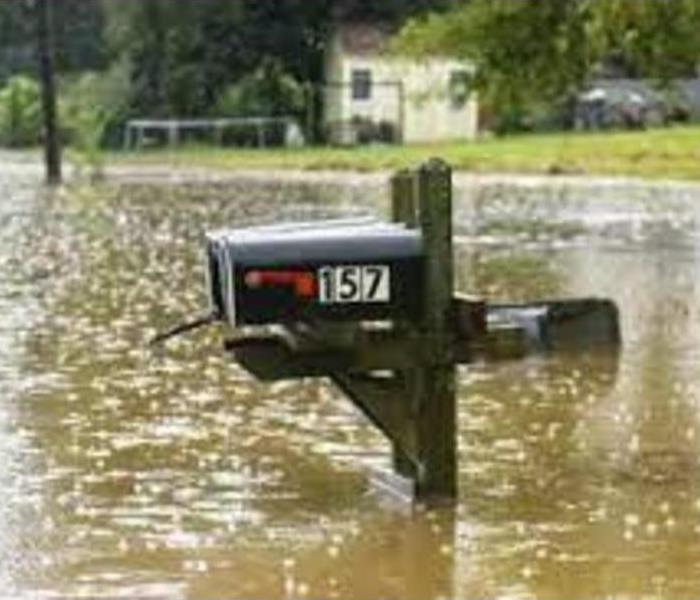 Your home or business has been the casualty of a flash flood. What should you do?
Your home or business has been the casualty of a flash flood. What should you do?
Immediately following a flash flood:
- Stay tuned in.
During flash flood recovery, it is essential to listen to local radio, TV, or your weather radio for necessary information. Flood dangers may still be present even after the water has receded. These news outlets will keep you informed of when it is safe to return or venture out. - Assess utilities.
Turn off electrical if you see sparks, broken/frayed wires, or smell smoke/burning insulation. If you have to step in water to get to a fuse box or circuit breaker, consult an electrician for advice. If water or sewage lines have been damaged, consult a licensed plumber straightaway. If you smell natural gas or propane or hear a hissing noise, vacate the area immediately and contact the fire department. - Don’t drink the water.
Do not drink tap or well water until it is has been declared safe for consumption and free of human waste contamination, fuels, and other pollutants. Don’t use it to brush teeth, prepare food, wash dishes, make ice, or even wash your hands with it. Undamaged water heaters and melted ice cubes may offer a clean source of water to get you by. If you don’t have access to safe water:- Boil water:
Boil for one minute, then cool, storing in clean, covered containers. This will destroy most types of disease-causing microorganisms. - Bleach:
Bleach will kill some – but not all - types of bacteria. 1/8 teaspoon or eight drops of regular, unscented, liquid household bleach per gallon should be used. Let water stand 30 minutes before using.
- Be overprotective.
Keep a close eye on children of all ages as well as pets. - Avoid flood-ravaged areas.
Barricades have been erected for your protection. Additional flooding may occur, roads may have been damaged, and an array of hazards – both visible and invisible – may be present. Staying off of roadways also helps emergency workers more easily get to flood victims in need of flash flood recovery. - Keep away from moving water.
Just six inches of moving water can knock you off your feet, and a couple of feet can carry away most vehicles. Avoid moving water at all costs. - If you must travel, use extreme caution.
Only travel through flood damaged areas when absolutely necessary. If you must travel, wait till water has stopped moving, wear sturdy shoes, and use a stick to gauge depth and firmness prior to taking each step. Be wary of contaminated water (gas, sewage, etc.), electrical hazards, hidden animals, dangerous debris, eroded roads and walkways, and more that can quickly land you in a dangerous situation whether you are traveling by foot or car. Avoid entering any structure surrounded by floodwaters that may be weakened until they have been declared safe from collapse.
Cleaning up and repairing:
- Get help.
Contact SERVPRO of Kendall County for restoration services for water damaged items. - Disinfection protection.
Once floodwaters have receded, carefully clean and disinfect each wet item to protect your home and family from sewage or chemical contaminants. Be certain to wear protective clothing, including rubber gloves and boots, during cleanup activities. - Floods and food.
Any items that have come in contact with floodwaters should be thrown out. This includes bottled water, canned goods, plastic utensils, baby bottles, and more. When in doubt, throw it out! - Scammers and con artists.
Hire only professional, reputable contractors for cleanup and repair needs. Avoid the “drive-by” contractor. - Safe drainage.
Should your basement become flooded, drain it gradually – about 1/3 per day – to prevent structural damage and collapse that may result from rapid water removal. - Insurance claims.
Contact your insurance agents to discuss flash flood recovery claims. The typical homeowner’s insurance policy does not cover flood damage. Call to verify coverage before flash flooding – and the need to file a claim – affects you.
During Storm Season, Make Sure Your Sump Pump is Working Properly
8/5/2022 (Permalink)
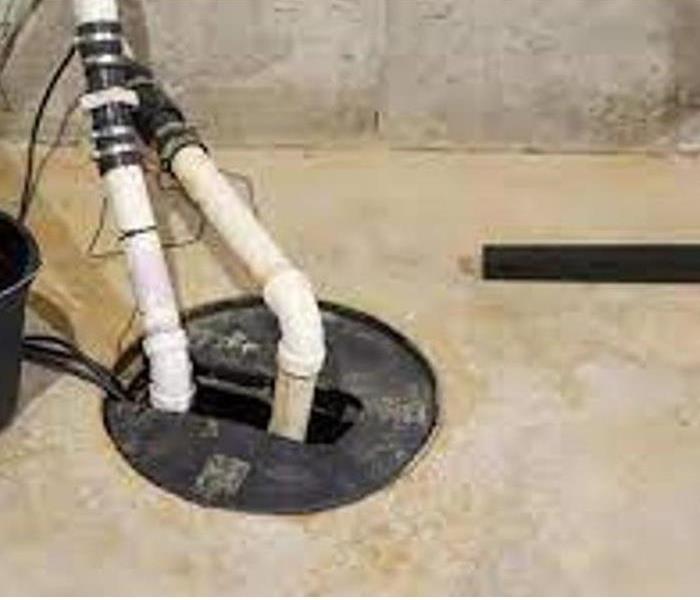 The sump pump removes the water and dumps it at a designated area outside through its discharge pipe.
The sump pump removes the water and dumps it at a designated area outside through its discharge pipe.
If you live in an area that is prone to flooding, you need to have a dependable sump pump and a good battery backup system. Because of their location below other floors of a building, basements and crawlspaces are prone to flooding, and this can cause notable damage and health issues in your home.
When water accumulates in your basement or crawlspace, the moisture can cause significant damage to the floor and walls. Humid conditions also cause the growth of mold, which apart from causing damage to walls, ceilings and other structures, also causes health problems like allergies and respiratory issues.
It is therefore important to have a mechanism that can efficiently and consistently remove water from areas that are prone to flooding. One of the ways to achieve this is by install a sump pumpand having a reliable battery backup system.
Sump pump?
This is a device that is used to remove water from areas that are susceptible to flooding. To play their role effectively, sump pumps are positioned in the lowest points in a home, notably within the crawlspace or the basement.
How a sump pump works
A sump pump is designed such that it turns on automatically when the level of water at the point where it is located reaches a certain point. This happens during occurrences such as flooding when it rains or when there is a substantial leakage from the plumbing systems. The sump pump removes the water and dumps it at a designated area outside through its discharge pipe.
How a battery backup system can help you
A battery backup system helps ensure that your sump pump is on standby at all times. Interestingly, flooding of a basement is in most cases associated with bad weather. Storms and falling trees can leave you without power. Yet it is during storms that your sump pump needs to be up and running.
With a battery backup system, you are able to protect your home from flooding by ensuring that your sump pump has power even when the mains electricity fails. A battery backup system turns on automatically any time there is a power outage in your home.
So, by installing a good battery backup system, you will not have any reason to worry in the event that there is a storm because your sump pump will function normally.
FEMA May Help after a Storm Hits
8/3/2022 (Permalink)
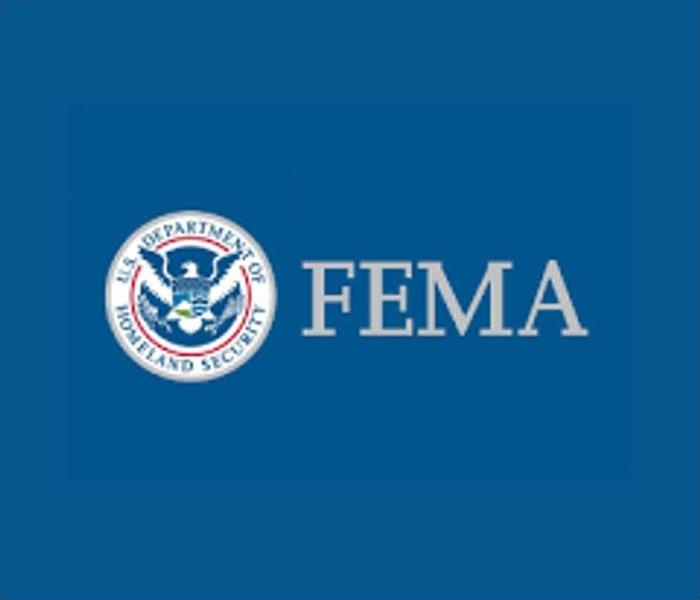 FEMA aids individuals and families who have disaster caused damages to their homes as a result of a presidentially declared disaster.
FEMA aids individuals and families who have disaster caused damages to their homes as a result of a presidentially declared disaster.
Survivors who have uninsured or underinsured losses may be eligible for FEMA help to make their homes livable.
Understand What Losses FEMA May Cover
FEMA assistance differs from insurance. Assistance only provides the basic needs to make a home safe, sanitary and functional. FEMA assistance does not make you whole again, but it can give you a helping hand to recover. FEMA disaster assistance covers basic needs only and will not normally compensate you for your entire loss.
Home damage must be related to the storm. FEMA inspectors may contact survivors who registered for help to conduct a remote inspection and calculate losses.
Examples of Safe, Sanitary and Functional Repairs to Make a Home Fit to Live in:
- Property: FEMA may assist with the replacement of or repairs to disaster-damaged heating, ventilating, and air-conditioning systems as well as refrigerators and stoves. Other possible repairs that may be covered are utilities such as electrical, plumbing and gas systems. Non-essential items like dishwashers and home-theater equipment are not covered.
- Ceiling and roof damage: FEMA may assist to repair disaster-related leaks in a roof that damage ceilings and threaten electrical components, like overhead lights, but not simple stains from roof leaks.
- Floors: FEMA may assist to repair a disaster-damaged subfloor in occupied parts of the home, but not floor covering like tile or carpet.
- Windows: FEMA may assist with disaster-related broken windows, but not blinds or drapes.
Other FEMA help may include temporary expenses to pay for lodging if a survivor’s home is uninhabitable, or assistance replacing essential household items.
As every survivor’s situation is different, FEMA calculations on what it may cover vary. Expenses for repairs that exceed the conditions to make a home safe, sanitary and functional are ineligible. Assistance depends on a host of factors like insurance coverage and in some respects the ability to pay.
Spend Grants Wisely
Disaster grants should not be used for travel, entertainment, regular living expenses or any discretionary expenses not related to the disaster. Survivors should keep receipts for three years to show how they spent FEMA grants.
If grant money is not used as outlined in the letter, you may have to repay FEMA and you could lose eligibility for further federal assistance that could become available later.
If Assistance Is Not Enough to Repair your Home to its Original Condition:
After you apply for disaster assistance, you may be referred to the U.S. Small Business Administration. The SBA may contact survivors to offer them a low-interest disaster loan. Homeowners and renters who receive an application for an SBA loan should complete the application even if they decide not to take it.
- For?businesses of any size?and certain nonprofits: up to $2 million for property damage.
- For?small businesses, smallbusinesses engaged in?aquaculture and most nonprofits: up to $2 million for working capital needs even if they had no property damage, with a $2 million maximum loan for any combination of property damage and working capital needs.
- For?homeowners:up to $200,000 to repair or replace their primary residence.
- For?homeowners and renters:?up to $40,000 to replace personal property, including vehicles.
Watch for High Winds and Tornadoes
8/1/2022 (Permalink)
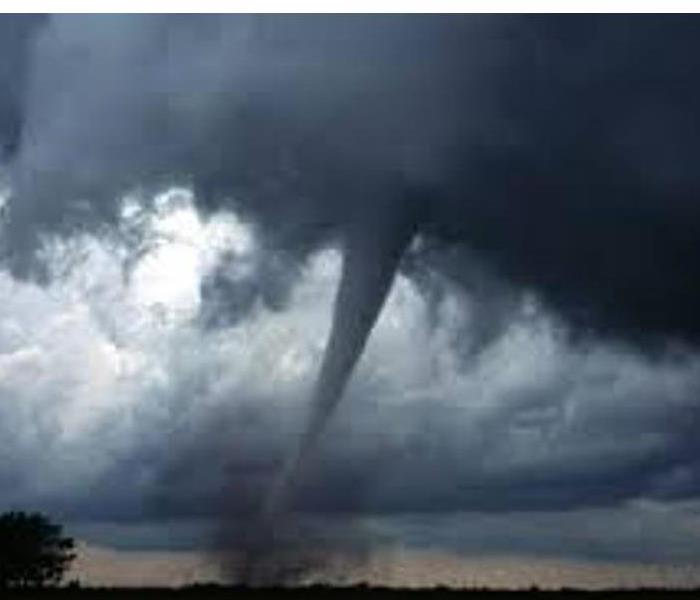 Learning what to look for and how to properly prepare can save lives and minimize damage.
Learning what to look for and how to properly prepare can save lives and minimize damage.
High winds are a danger to people and property. Learning what to look for and how to properly prepare can save lives and minimize damage.
WIND CHARACTERISTICS
Wind damage can come from wind alone or from severe weather events, such as thunderstorms and tornadoes. Damaging winds that are not associated with tornadoes are often called “straight line” winds; they are often caused by strong thunderstorms. Damaging winds are defined as exceeding 50-60 mph; they can reach up to 100 mph, can produce a damage path extending for hundreds of miles and are more common than tornado damage. Anyone residing in thunderstorm-prone areas is at risk of this hazard. Structures of lesser construction, such as unbraced frame buildings and mobile homes, are at greater risk.
TORNADO CHARACTERISTICS
A tornado is a narrow, violently rotating column of air that extends from the base of a thunderstorm to the ground. Characterized by a long, funnel-shaped cloud that is made visible by condensation and debris, roughly 1,200 tornadoes hit the U.S. every year. Peak tornado season for the southern plains runs May into early June; on the Gulf Coast, it is earlier in the spring; and in the northern plains and upper midwest, tornado season is June and July. Tornado strength is rated on the Enhanced Fujita Scale, with ratings from EF1 to EF5.
TORNADO ALERTS
Two different alerts warn of impending tornadic activity:
- Tornado Watch: A watch is issued by the NOAA. A watch means that weather conditions are favorable for tornadoes. A watch can cover parts of a state or several states; it indicates that one should watch or prepare for severe weather and stay tuned to the radio for a warning.
- Tornado Warning: A warning is issued by the local NOAA National Weather Service Forecast Office. A warning means a tornado has been reported by spotters or indicated by radar and there is a serious threat to life and property to those in the path of the tornado. A warning should heed immediate action to find safe shelter.
WIND SAFETY
Being prepared prior to a high wind event as well as knowing what actions to take during and after a thunderstorm can be the difference between life and death. Consider the National Weather Service’s following safety tips for both places of business and your home.
Before a high wind event or tornado:
- Trim tree branches away from your building and power lines.
- Secure loose gutters and shutters.
- Identify an interior room or area of refuge – such as bathrooms or basements – that can be used as a safe room of shelter during high wind warnings.
- Consider having emergency supplies available, including medical supplies, water and food in the event your building cannot be evacuated.
- Establish an emergency action plan to address all potential catastrophic weather events including high wind storms and tornadoes. This should include an emergency meeting place or room, a method of taking attendance, notification methods and drills.
During a high wind event or tornado:
- Go to your pre designated area of refuge – an interior area, such as a bathroom or basement – for shelter.
- Stay away from glass and windows that could be hazardous if broken during the storm.
- Tune to a trusted weather source for updates on storm conditions and location, so you know when you can safely leave your safe area.
After a high wind event or tornado:
- Do not go near downed power lines. Report them to police and avoid them until a professional has evaluated them and deemed the area safe.
- Be careful when handling debris that may have blown on your property.
- Wear long pants, long sleeved shirts and sturdy shoes when assessing damage. If possible, stay out of damaged buildings until authorities have deemed it safe.
PROTECTING YOUR HOME AGAINST SUMMER STORM
7/5/2022 (Permalink)
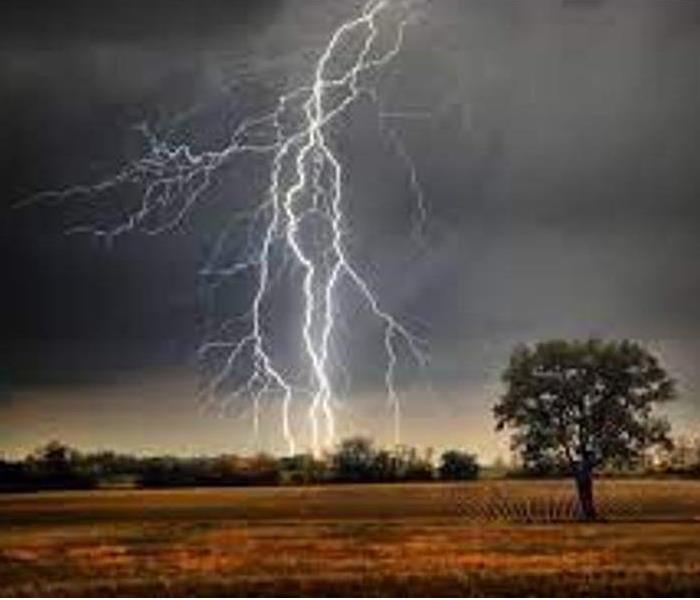 Summer is finally here, and along with it comes a different kind of inclement weather.
Summer is finally here, and along with it comes a different kind of inclement weather.
Summer is finally here, and along with it comes a different kind of inclement weather: thunderstorms and worse, tornadoes. Because our Illinois climate is conducive to severe summer weather, it’s important that you properly prepare your home each summer season to help mitigate storm-related damage.
At SERVPRO of Kendall County, we know storm damage repairs and water damage restoration aren’t necessarily at the top of any homeowner’s wishlist. So help you get prepared this summer season, below, we’ve listed the steps you’ll need to take to protect your home.
Trim Your Trees
Do you have large trees in your yard? Do any branches extend over the roof of your home — or anywhere near it? If so, it’s important to trim back those branches each year, preferably before summer storm season hits.
Heavy winds can force branches to break free from large trees, and when those branches fall, they can land on your roof, damage your siding, and potentially, puncture your home. You’ll then be left to deal with glaring damage to the outside of your home, and potentially, extensive damage to the inside, too. Because rainwater will easily enter through a gaping hole in your roof or siding, you’ll likely also be facing water damage restoration if you fail to maintain your trees properly.
Clean and Inspect Your Gutters
When your gutters are damaged or full of debris, water cannot flow through the channels as efficiently as it should. And when summer storms bring heavy rainfall, clogged and damaged gutters can’t handle rapid water accumulation.
As pouring rain fills clogged gutters to the brim, water eventually begins to spill over the sides of the gutter, landing adjacent to your home’s foundation. Unfortunately, water accumulation around your foundation can cause a host of problems, including:
- Basement or crawlspace flooding
- Mold and mildew growth
- Foundation shifting, if the water exposure is prolonged
- Compromised structural integrity
To avoid water accumulation around your home’s foundation, make sure you inspect and clean your gutters at least twice per year, and more frequently during extended periods of inclement weather. Water damage restoration is an extensive process, but it can often be avoided simply by practicing routine maintenance.
Get a Roof Inspection
Even if you had a roof inspection last year, schedule another one before summer storms make their appearance. Your roof provides a critical layer of protection against the outside elements, and even minor damage can compromise its structural integrity.
Because harsh winter weather, snow accumulation, and ice dams can cause unseen damage to your roof, it’s important to schedule annual roof inspections even if you cannot readily detect deterioration or damage. A professional roof inspector knows exactly what to look for in terms of roofing red flags, which include:
- Damage to roof flashings, which can allow water to leak inside your attic
- Wood rot or warping due to moisture accumulation beneath the shingles
- Missing, cracked, curled, or otherwise damaged shingles
- Mold and mildew proliferation, which signify water damage and compromised structural integrity
Because your roof plays such an integral role in the protection of your entire home, having yearly inspections is one of the best ways to avoid weather-related problems and storm damage repairs.
WAYS HEAVY SNOW IMPACTS HOMES
2/2/2022 (Permalink)
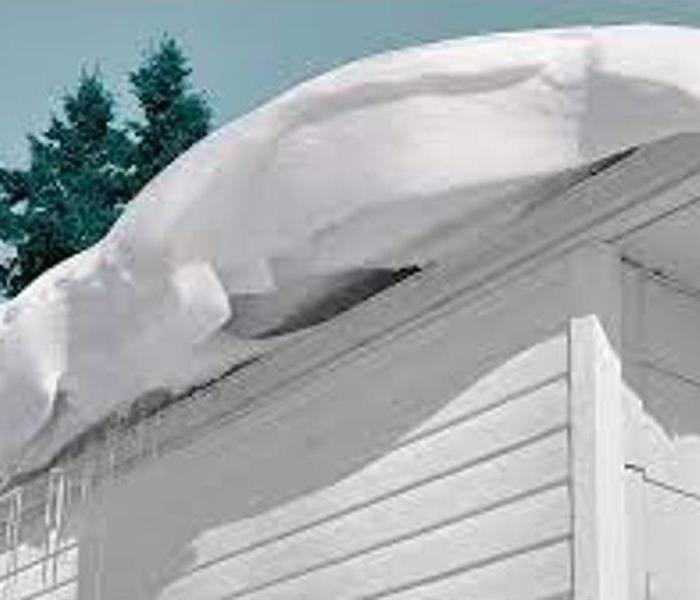 Generally, roofs can withstand 20 pounds of snow per square foot before their structural integrity is compromised
Generally, roofs can withstand 20 pounds of snow per square foot before their structural integrity is compromised
1. Ice Dams and Snow Piles
If your area sees lots of heavy snow, make sure your roof is ready before the weather arrives. Too much snow or ice on your roof can cause it to weaken, leak or even collapse. Generally, roofs can withstand 20 pounds of snow per square foot before their structural integrity is compromised. Packed snow is heavier than fresh snowfall, so the faster you clean off your roof after a heavy snowstorm, the safer it will be. If you suspect your roof needs maintenance or you've noticed ice dams form in the past, have your roof inspected and repaired before winter to ensure it can hold up under heavy snowfall.
2. Indoor Accidents
Snow days often seem like stolen time. With no work or school, you're free to relax, play games and have fun with your kids at home. If you're kids get energetic when they're cooped up inside, you may be looking for any way to keep them entertained. With all that extra time inside, however, you need to be extra careful about everyone's safety. Keep an eye out for toys and snow equipment that get strewn around the house, and keep things tidy to avoid injuries or accidents. The American Red Cross also recommends turning snow days into fire safety days. The rate of home fires spikes in winter, so lighting a fire or using a space heater on a snow day demands caution. Make sure your chimney is clean and any wood you burn is dry, and use space heaters that are equipped with automatic shutoffs.
3. Kitchen Fires
Staying home could also mean extra cooking or baking, whether it's homemade hot chocolate, popcorn, cookies, soup, or a special snow day dish your family loves. Make sure your kitchen is a safe zone, too. Follow all our winter fire safety tips to avoid starting a fire on a snow day. Since heavy snowfall could make it harder to get help during an emergency, you'll be safer taking precautions than taking a risk. Snow days should be more fun than worrisome.
3 Common Types of Roof Storm Damage
2/2/2022 (Permalink)
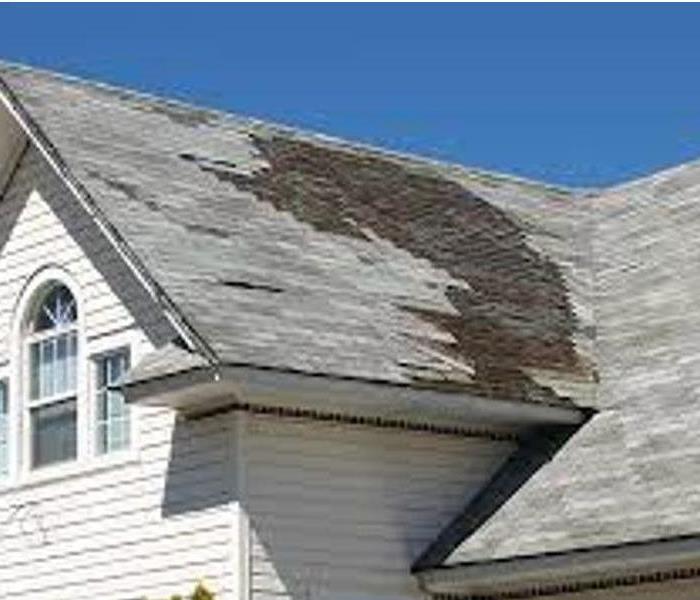 Weather conditions like snow, high winds, and ice can gradually create prolonged damage to roofs.
Weather conditions like snow, high winds, and ice can gradually create prolonged damage to roofs.
Different kinds of storm damage pose their own problems. Make sure you understand how the aftermath of common storms could affect your roof.
1. Water Damage
Moisture damage is the most common culprit and the easiest to spot. After heavy rainfall, it’s possible that your entire home could be affected by water damage. To avoid mold, structural problems, and rotting, schedule a roof inspection with SERVPRO of Kendall County right away. Even a small leak can cause expensive problems down the road!
2. Hail Damage
After a hail storm, you may notice dings in your metal roof, dark spots on your shingle roof, or even cracks in your siding. However, roof hail damage can be difficult to identify and even go undetected until more damage is done. Instead of waiting until it’s too late, it’s best to have a professional like SERVPRO of Kendall County come to take a look.
3. Wind Damage
Heavy winds are not only frightening, but they can also ruin shingle roofs, especially in the event of a tornado. Strong winds are powerful enough to lift your shingles and even permanently misplace them, leaving empty space for water to travel into and causing leaks. Wind can also send flying debris to your roof, resulting in cracks, holes, and other problems.
Have Your Home Ready for Spring Storms
2/2/2022 (Permalink)
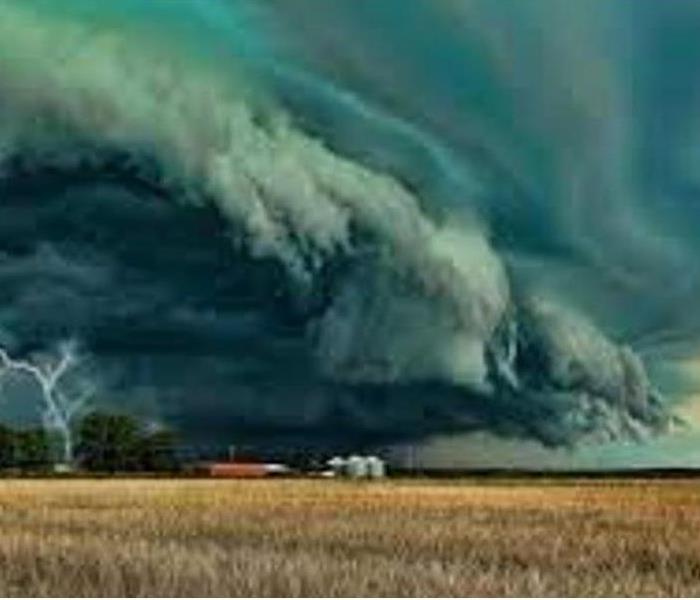 Spring storms can be intense, have your home ready, just in case.
Spring storms can be intense, have your home ready, just in case.
While it's true that it's difficult to predict Mother Nature, you can take steps ahead of time to prepare your home for spring storms, minimize damage and keep your family safe. Use these tips to prepare for whatever Mother Nature has in store this season:
- Prune dead or rotting branches from trees near your home or car that could fall during a storm.
- Stock an emergency kit with water, non-perishable food, a first-aid kit, flashlights, extra batteries, and a battery-operated radio in case of a storm-related power outage.
- Use surge protectors for electronic equipment in your homes such as computers, televisions, and appliances.
- Install a lightning protection system that will redirect lightning strikes safely into the ground.
- Know how to shut off the power to your house using the main fuse or breaker on the electrical service panel, and how to shut off water and gas support lines if instructed by disaster officials.
- Learn about flood insurance at floodsmart.gov. Floods and flash floods occur in all 50 states and most homeowners insurance policies do not cover flood damages — even an inch of water can cause thousands of dollars in damage.
- Check the condition of your roof and make any needed repairs to minimize damage in a storm. Clean gutters and downspouts so water will be diverted away from your home.
If a storm is imminent, it's time to batten down the hatches right away and think safety:
- Use your TV, radio, or the Internet to stay up to date on changing weather conditions. Know the difference between a storm watch and the more serious storm warnings issued by the National Weather Service.
- Tie-down or bring inside anything that could be blown around such as trash cans, barbecue grills, and outdoor furniture.
- Get inside and close your windows and doors. Pull the blinds and drapes so that if the glass is broken, it's less likely to fly into the house.
- Unplug expensive electronic equipment.
- Set your refrigerator and freezer to the coldest setting. In case of a power outage, food will be colder and last longer.
These steps can help you feel prepared for the uncertainty of the spring storm season.
Steps to Handle Winter Storm Damage
1/11/2022 (Permalink)
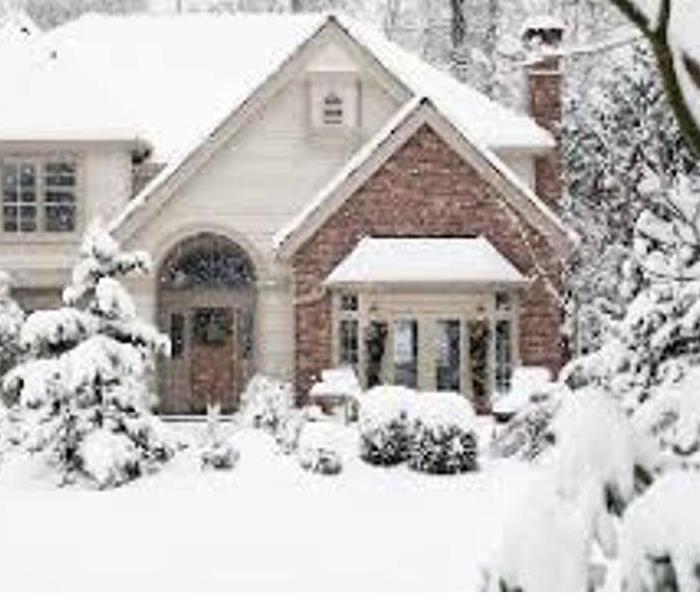 The most common types of property damage caused by severe winter weather are roof damage or collapse due to snow, ice or sleet, and water damage from
The most common types of property damage caused by severe winter weather are roof damage or collapse due to snow, ice or sleet, and water damage from
Common Types of Winter Storm Damage You Might Face
It’s easy to imagine getting snowed in or having to deal with slippery surfaces due to ice, but there are actually many potential emergencies caused by winter storms. It’s a good idea to know some common disasters you might be up against before a storm arrives.
- Flooding — Cold snaps and freezes can damage pipes and cause them to burst, leading to water damage and flooded areas that need emergency restoration.
- Fires — Whether it’s due to unattended fireplaces, improperly cleaned chimneys, or space heaters plugged into overloaded outlets or left too near flammable objects, fires can often happen during a winter storm.
- Roof leaks — Frozen ice that melts, ice dams that block drainage pipes, heavy snow and ice breaking through shingles, hail strikes, and even high winds from winter storms can all be harsh on your roof, leaving your property exposed to moisture damage.
What to Do if Your Property Is Damaged
Once a winter storm strikes, your property can be left facing a number of things that need fixing fast. And if you don’t know what to do next, the situation can feel overwhelming. To help you get quick, effective storm restoration for your commercial and personal property, here’s a list of 7 immediate actions to take when you’re facing a storm-related disaster.
1. Stay calm.
It’s tempting and natural to freak out when an emergency arises. But do what you can to take a few deep breaths, so you can think straight. It’s important to make good decisions. So, while you may need to quickly act to put out the immediate fires, so to speak, you also owe it to yourself to take your time with the decisions that need careful assessment.
2. Ensure everyone’s safety
When your property has suffered damage, it may put people on the premises at risk. So, be sure your family, guests, clients, and employees are safe. Move everyone out of any areas that are affected. Do a headcount to make sure you know where everyone is. If the property is unsafe, you may need to arrange for a temporary place for the family to stay or for employees to work while the property is fixed.
3. Turn off power and water to affected areas
Often, winter storms can lead to leaks or floods from damaged roofs or burst pipes. Keeping the water running may make flooding worse while leaving electricity flowing could lead to a fire that compounds the damage. So, know where cutoff valves and breakers are located. Shut off the flow to damaged areas, and call utility companies if you need their assistance.
4. Document any losses
As soon as you can, make detailed notes of anything that is affected by the storm damage. This might include everything from furniture and business equipment to personal documents, valuables, and more. This list will be useful in making insurance claims and obtaining replacements to help get you back on your feet fast. Take photos of everything too, especially before anything is done to fix problems. This is essential for the insurance claim process.
5. Contact your insurance company
Once the immediate danger is passed — the storm is over, the fire is out, the flooding is contained, etc. — then it’s time to reach out to your insurance company. Call your agent to get the process of filing a claim started. Ask what you will need to provide (documents, photos, etc.) to back up the claim. Leave everything in place, except for what must be moved for safety, until the adjuster comes to document what happened.
6. Remove property from damaged areas
As soon as you have documented the damage, you’ll want to move property out of the danger zone quickly to minimize further damage. Valuables and important papers take the first precedence, because they may be impossible or very difficult to replace. After that, move items that you’d like to save but that can be replaced, such as furniture and electronics. Keep in mind that a restoration company can often help restore these items as well as the building itself.
7. Keep all receipts and documentation
Once the storm restoration process begins, you’ll end up with a lot of paperwork. Hold onto everything — photos, lists, videos, estimates, invoices, claim forms, receipts, etc. Put it all in one file for safekeeping. Consider creating an electronic file for this information in a cloud storage account so you can access it from anywhere. SERVPRO of Kendall County will assist you with all your needs along the way.
PROACTIVE WINTER WEATHER MANAGEMENT FOR PROPERTY MANAGERS
10/6/2021 (Permalink)
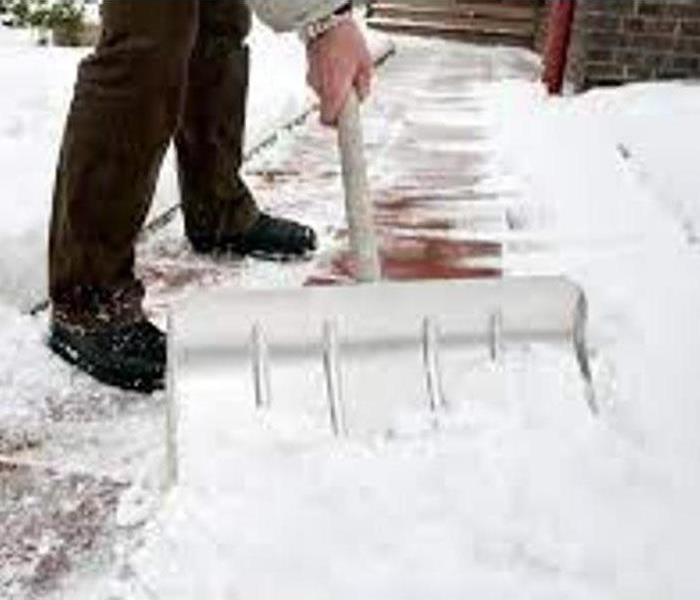 Winter weather can cause serious damage to your property if you aren’t prepared.
Winter weather can cause serious damage to your property if you aren’t prepared.
If you are a property manager, then you probably dread the winter time. Winter weather can cause serious damage to your property if you aren’t prepared. Fortunately, there are things that you can do in order protect your property against the cold and snowy winter months.
Reserve Your Snow Clearing Contractor
It should be on your priority list to receive snow removal, plowing, and de-icing solution when managing residential properties. You can avoid a headache and save time by reserving a snow cleaning contractor ahead of time and remaining loyal to them over the months and years for repeat business. It is important for rental property management companies to be proactive about weather concerns, rather than reactive… ie: Late to make important calls.
Inspect the Outside of Your Property
If you will be expecting cold weather, then it is important for you to make sure that your property is in tip-top shape inside and out. Seemingly harmless imperfections can create major problems later on down the road from roofs, HVAC, exposed pipes, chimneys, windows, and doors, etc. There are so many facets to a home that can lead to not keeping that cold air/snow out while maintaining the warm air inside.
Check for Snow on the Roof
Roof problems are one of the biggest property issues that our Raleigh property managers have to deal with. Most of these issues depend on the age of the home and prior condition of the roof structure. There are some things that can be done to prevent issues from occurring in the future, like checking to make sure all the vents are free of debris so that the melting snow can drain properly. This is also a great time to check and clear all gutters on the home.
Take Fire Prevention Steps
Holiday activities increase the risk of fires such as space heaters, candles, and interior/exterior lights can all increase the risk. It’s highly important to check smoke detectors and carbon monoxide detectors are in full working order. Also, have wood-burning fireplaces inspected regularly. It’s never a bad idea to review fire safety guidelines with your tenants.
Stock up on De-Icing Products
You can prevent falls by using de-icing and anti-icing products on walkways and sidewalks and patios. As the name suggests, de-icing products melt the ice and snow for more traction. Anti-icing products prevent the snow from building up. Our property managers recommend using a combination of both in order to get the best results.
WAYS THAT WEATHER CAN DAMAGE YOUR HOME
9/21/2021 (Permalink)
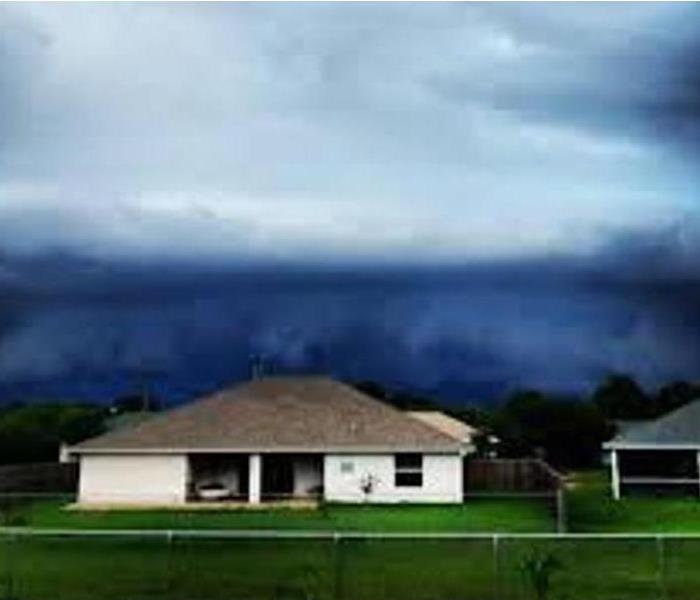 Most don’t usually relish discussing how the weather can damage their home.
Most don’t usually relish discussing how the weather can damage their home.
Here are seven different ways that weather can cause damage to your home.
1. Wind. This is probably the most obvious type of damaging weather pattern. Extremely powerful winds from tornadoes and hurricanes can scrape the shingles off the tops of roofs and pull gutters away from rooflines. But even wind gusts that aren’t as strong can cause large tree limbs to break and fall onto homes, which can cause roof leaks and bring down gutters.
2. Hail. Millions of dollars in damages are common from just a single hailstorm. If the hailstones are even moderately sized, their weight — coupled with the force at which they fall from the sky — can poke holes in the shingles of a roof. Large hailstones can even dent or bend gutters as well.
3. Rain. Though the rain itself usually doesn’t cause structural damage, any water that leaks into a home through gaps in the roof or walls can lead to messes that can be costly to clean up. This water can also lead to damage to walls, ceilings, and floors; as well as mold and mildew problems throughout a home. Also, too much rainwater in a short period of time can overload gutters, causing the rain to fall onto the ground where it can damage the foundation over time. (And of course, rain tends to cause flooding, which has its own problems.)
4. Cold. Wintry temperatures (usually below 20 degrees) can affect a home even when there is no precipitation. Frigid conditions can cause pipes to freeze; and if they burst, flooding can occur in basements or rooms. Pipes that are most susceptible to freezing include those connected to outdoor spigots and/or run through uninsulated walls and attics.
5. Snow. A little bit of snow usually doesn’t cause any problems. But multiple feet of snow can weigh on a roof or gutters and overwhelm physical support systems; causing buckling or holes in roofs and bending or breaking gutters. The same effect can be seen on overhanging tree branches, which can fall onto houses and wreak additional havoc.
6. Ice. During prolonged periods of precipitation and/or cold temperatures, ice can build up a gutter to form an ice dam. These dams, which are fed by snowpack on roofs, can not only buckle and dislodge gutters; but the ice can also creep underneath shingles to damage the roof. This, in turn, can lead to leaks through which eventually melting ice can enter a home’s attic or interior.
7. Sun. Even when the sun is shining, certain parts of your home could be susceptible to damage. During prolonged periods of heat, the sun can damage furniture, rugs, and artwork by fading colors and making fibers brittle. But wise usage of shades and drapes (or even tinting windows) can keep this from happening.
STORM PREPARATION TIPS FOR YOUR HOME
9/15/2021 (Permalink)
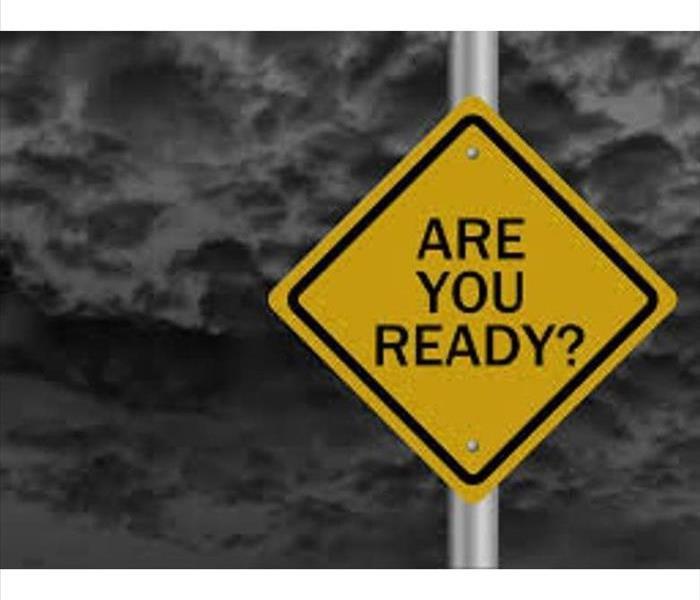 Prepare today with these home storm preparation tips.
Prepare today with these home storm preparation tips.
Spring and summer are notoriously stormy. Your home could be at risk of flooding or wind damage. Don’t wait until a severe storm warning is issued in your area—prepare today with these home storm preparation tips.
- Inspect the gutters and downspouts: Gutters must be clear of debris to drain properly. Clean them twice a year or consider installing a gutter guard system. Also, set up downspout extenders that deposit water at least 6 feet from your foundation.
- Have your roof inspected: Every few years or following a hailstorm, hire a roofing company to check for damage. Patching up holes before it rains again can prevent destructive roof leaks.
- Check water flow on your property: During heavy rain, go outside and observe how water flows around the house. With clean gutters and extended downspouts, rain should run away from the foundation. If the soil grading slopes toward your home, correct this before the next storm.
- Inspect the crawlspace: Another place to check during heavy rain is the crawlspace. Look for evidence of water intrusion, such as discoloration, staining, musty odors and/or mold growth. Clean up the damage and correct the drainage on your property to prevent a recurrence.
- Trim your trees: If any branches overhang the roof or brush the side of your house, they could cause damage during a storm. Prune your trees to help protect your property and consider re-grading the soil to give the roots something sturdier to cling to in high winds.
- Secure your home: Consider installing window shutters or temporary plywood to keep your home tight and secure against the wind. If the windows break, your roof and garage door are more likely to fly away. Roof clips and garage door braces can also help secure these parts of your home.
- Install a generator: Long-term power outages can be inconvenient or even dangerous. Keep the lights on, food chilled, and HVAC system running with a backup generator.
- Install a sump pump: Flooding is one of the most common types of storm damage. Prevent groundwater from rising into your home by installing a sump pump in the basement. Include a battery backup to ensure continued operation during a blackout.
- Unplug electronics: When a storm starts to pick up, it’s best to unplug small appliances and electronics. Lightning strikes can cause serious power surges and damage sensitive gadgets, even if they’re plugged into surge protectors.
- Clear clutter from your yard: If a storm warning is issued, bring any loose outdoor objects inside. Patio furniture, potted plants, toys and trashcans can be swept away if left at the mercy of a tornado or hurricane.
Not All Water Damage Is Created Equal
8/15/2021 (Permalink)
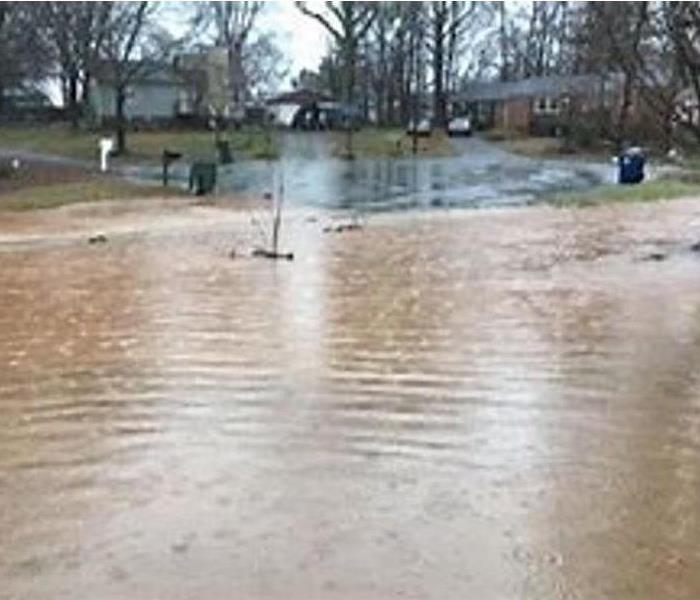 Specific steps must be taken to reduce property destruction, depending on the type of water damage.
Specific steps must be taken to reduce property destruction, depending on the type of water damage.
How many of you remember as a kid playing in or around storm water drains or roadside ditches? It was fun, right? While you may have enjoyed splashing around in the waters, you might not realize that storm water like this may actually be contaminated with raw sewage, dangerous chemicals, or harmful bacteria and viruses capable of transmitting dangerous diseases to you.
In this same way, the harmful water that invades your home following a broken pipe, clogged toilet overflow, leaking dishwasher, overflowing washing machines, leaky roofs, or even foundation crack can be harmful.
Restoration Depends on Water Type
Specific steps must be taken to reduce property destruction, depending on the type of water damage. According to the Institute of Inspection Cleaning and Restoration Certification (IICRC), who sets the standards for the cleaning industry and water damage restoration training, there are three levels or types of water involved in damages. They include:
Category 1: Clean water
This water damage is from sanitary sources, such as an overflowing sink or tub, burst water pipes, failed supply lines to appliances, drinking fountains, or vertical falling rainwater.
Category 2: Grey water
This water is from sources that could make you uncomfortable or ill if ingested. Washing machine, dishwasher, or urine-tainted toilet overflows belong in this category.
Category 3: Black water
This is the worst classification of water and could cause severe illness if ingested. Sewer backups, flooded rivers, feces-tainted toilet overflows, or stagnant liquid that has bacterial growth are all examples of black water.
Let the Experts at SERVPRO of Kendall County Save Your Home and Belongings
Seeping water damage is progressive, pervasive and can mean valuable objects or keepsakes may become permanently damaged. The professionals you find at SERVPRO of Kendall County are trained on how to handle the various types of water damage. Once they arrive on the scene at a home or business, they quickly assess the situation and start the restoration process in these three areas:
- Aggressive cleaning: Wall cavities and other surfaces are pressure washed with a detergent solution. Salvageable materials are flushed and thoroughly disinfected.
- Moisture detection: Not all water damage is visible to the naked eye. Water trapped in structural cavities may require sophisticated detection equipment to mitigate odors, prevent mold growth and minimize structural damage.
- Rapid Structural Drying: Mold begins growing on soggy surfaces within only 24 to 48 hours. Rapid drying, all the way down to the building’s substructure, is necessary to restore pre-flood conditions.
After your home floods, you may think your home and its contents are beyond hope, but many of your furnishings and belongings can be restored. With SERVPRO of Kendall County helping, your flooded home can be cleaned up, dried out, rebuilt, and reoccupied sooner than you think.
Storms Come in Many Forms
8/11/2021 (Permalink)
 A simpler way of classifying storms: thunderstorms, tropical cyclones, and extra-tropical cyclones.
A simpler way of classifying storms: thunderstorms, tropical cyclones, and extra-tropical cyclones.
Research meteorologists and climatologists have a simpler way of classifying storms: thunderstorms, tropical cyclones, and extra-tropical cyclones. All are atmospheric disturbances that redistribute heat and produce some combination of clouds, precipitation, and wind.
All three require moisture, energy, and certain wind conditions to develop, but the combination of ingredients varies depending on the type of storm and the local meteorological conditions. For example, thunderstorms form when a trigger—a cold front, converging near-surface winds, or rugged topography—destabilizes a mass of warm, humid air and causes it to rise. The air expands and cools as it ascends, increasing the humidity until the water vapor condenses into liquid droplets or ice crystals in precipitation-making clouds.
Tropical cyclones—more commonly known as hurricanes and typhoons—occur when many thunderstorms organize into a larger system and begin flowing in a circular pattern around a low-pressure center. These storms thrive on warm ocean temperatures for energy; sea surface temperatures need to be above 80°F for a tropical cyclone to form. However, they cannot thrive when the wind shear is strong. Wind shear occurs when surface-level and higher-level winds are blowing at different speeds or in different directions.
Extra-tropical (or mid-latitude) cyclones, which can produce weather ranging from mild rainstorms to violent blizzards, are even broader storms that typically begin in the middle or high latitudes. While tropical cyclones draw their energy from warm air masses heated by equatorial oceans, extra-tropical cyclones draw their fuel from the interactions of fronts—large horizontal air masses with different temperatures or humidity.
THINGS TO REMEMBER ABOUT STORM DAMAGE INSURANCE CLAIMS
8/5/2021 (Permalink)
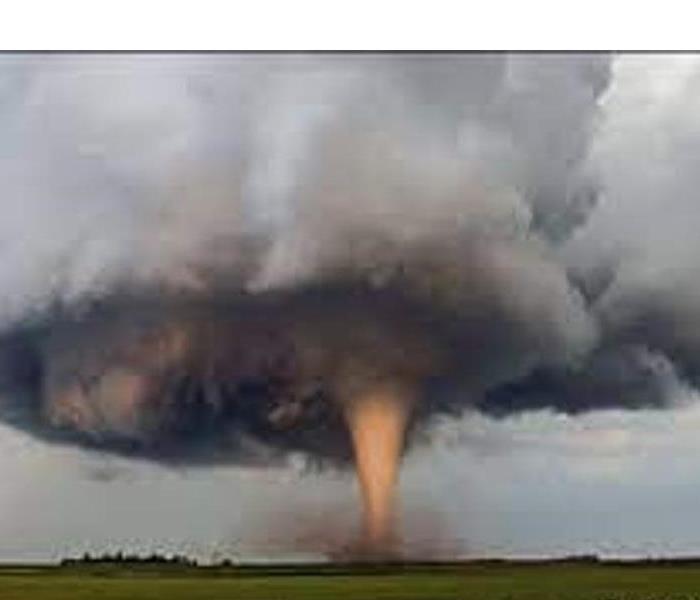 After the storm hits, be proactive about damage to your property
After the storm hits, be proactive about damage to your property
The weather can be very hard to predict, so you’ll never know exactly when a storm will hit your area. Unfortunately, a storm can seriously damage your roof. Damaged roofs cause costly water leaks, so you should act quickly to repair your roof.
- Look for Damage as Soon as You Can – Even if your roof looks intact from the outside, there could be significant damage to your roofing system. You should act quickly and call a reputable professional like SERVPRO of Kendall County to inspect your roof if you suspect that it is damaged. As soon as it is safe to do so, get your roof inspected.
- Document All the Details – You will need to take pictures and notes of all the damaged areas of your roof. In some cases, your roofing contractor will be able to assist with this task. This documentation will help you with your insurance claim and help you figure out if you need a roof replacement or a roof repair. Your insurance company needs as much information as possible.
- Contact Your Insurance Company – You should contact your insurance company as quickly as possible once you have documented the damage to your roof. Some insurance companies have a time limit on how long you can file a claim. Make sure to read your insurance policy carefully so you can understand your rights and responsibilities.
- Choose a Contractor You Can Trust – If your roof insurance claim is approved, then you need to choose a contractor you can trust with your roof repair or replacement. We suggest choosing a company that’s experienced with storm damage restoration and insurance claims. Fortunately, SERVPRO of Kendall County can assist you.
What to do if your pipes freeze
2/10/2021 (Permalink)
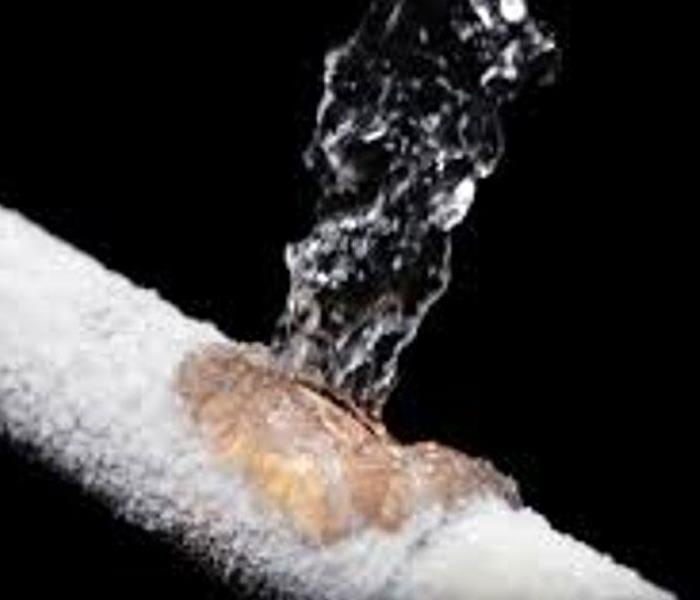 Frozen pipes can be messy--Know How To Handle Them
Frozen pipes can be messy--Know How To Handle Them
There are lots of things you can do to reduce the winter-related losses such as frozen pipes. However, if temperatures are extremely cold and you turn on your tap to find a trickle or nothing instead of a steady flow, you probably have frozen pipes somewhere in your home. Water expands when frozen, but pipes do not, which can cause a pipe to burst. If you discover you have frozen pipes, act quickly...don't wait for them to burst.
Frozen pipes
- Turn off the water supply. If pipes are frozen and in danger of bursting, you want to stop the flow of additional water into the pipes to reduce the potential for additional damage.
- Protect your possessions. Move any possessions near the frozen pipe to a safe area to prevent damage if it bursts.
- Locate the frozen pipe. Check water flow at faucets to determine if the frozen pipe is isolated in one area, more extensive, or close to where water comes into the home. Feeling along pipes can help to locate the frozen area. Look for bulging.
- Take action to thaw pipes immediately. Be attentive as you thaw pipes because sometimes pinholes or cracks can occur from freezing and then upon thawing leaks become evident. There are lots of do-it-yourself tips on the internet on how to thaw pipes...search "thawing frozen pipes". You may want to do some advance reading just in case. Be sure to open faucets near the frozen pipe to let steam escape and water flow out. We recommend calling a licensed plumber for assistance.
Burst pipes
- Turn off the water supply to stop the flow of water. Immediate action can be key to reducing additional damage. If it's an emergency and you don't know what to do, call the fire department. After the water is off, you can clean up the spill and work to reduce further damage. If a burst pipe is near any electrical switches or fuses, turn the power off at the panel. Never touch anything electrical if it's wet.
- Clean up, make temporary repairs and take steps to prevent further damage. An insurance adjuster doesn’t need to see the actual water spill before you start cleaning up. However, the adjuster will want to inspect any damaged items. Documenting damage with pictures and/or video can be helpful to the process. If the leak involves ceilings being saturated with water, be extra careful of weakened construction that could collapse and cause injury.
- Get professional help. Most of us aren't skilled enough to make proper repairs especially if the damage is major and/or within walls. A licensed plumber (and perhaps an electrician if electrical is involved) can help you make repairs.SERVPRO of Kendall County will remove water from your home and ensure that walls are dry to prevent a mold problem. Remember, mold cannot survive without moisture. You want to be sure repairs are done properly to prevent additional damage in the future.
Tips for Preventing Home Storm Damage
2/10/2021 (Permalink)
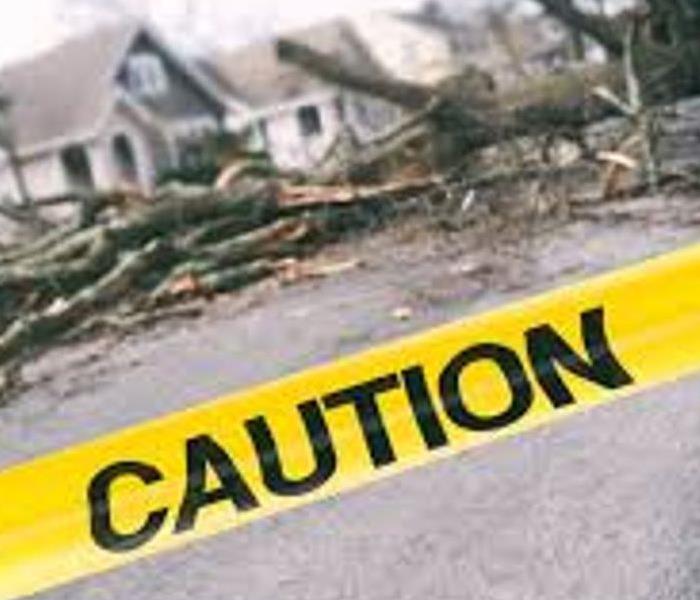 Be Pro-Active When it Comes to Preventing Storm Damage to Your Home This Spring
Be Pro-Active When it Comes to Preventing Storm Damage to Your Home This Spring
There are steps you can take to prevent damage to your home before storms strike. Consider the following:
Put Away Patio Furniture. You may have been spending more time at home this year and invested in patio furniture to enjoy your outdoor living space. A storm with gusty winds is likely to upend any objects that are not anchored down or stored. If you store items in your garage, don’t forget to secure the door. High winds can blow through the door and damage the contents inside.
Trim Trees and Clean Gutters. A simple exterior assessment can help you determine if you need to clean your gutters or remove loose tree branches vulnerable to wind gusts that could damage your home. Heavy rains can weigh down gutters, so firmly secure any loose gutters.
Create Home Safety Kit. To keep your home healthy and safe, you’ll want to make sure you have basic household items to last for a few days in case of an emergency. A disaster supplies kit should include water, non-perishable food, a first aid kit, and a flashlight. In the wake of COVID-19, FEMA suggests adding face coverings, soap/hand sanitizer, and disinfecting wipes to help prevent the spread of coronavirus or other viruses and the flu.
Repair Loose Roof Shingles. Roof damage makes your home susceptible to rain/water leaks if strong winds blow shingles off the top of your home. Make sure all shingles are secured properly. An experienced roofer will be able to make recommendations to remove and replace any loose shingles.
Prepare For A Winter Storm
2/10/2021 (Permalink)
 Winter is upon us know how to prepare for a winter storm
Winter is upon us know how to prepare for a winter storm
How To Prepare For A Winter Storm
If you are prudent enough, you can prevent most of the eventual winter storm damage. Here are several common-sense tricks on how to prepare your home to effectively withstand snowstorms, freezing rain, and chilly winds:
- Shoveling snow is good for your physical development and for your property.
Provide quality insulation for your home – make sure that the roof and the walls are in good condition. You may install storm windows or even weather-strip doors and provide additional layers of insulation wherever possible. Your fortress should be properly insulated before winter arrives;
- Provide alternative heating methods – electricity or gas supply could be cut off during a blizzard, so be sure to have an alternative heat source – a fireplace or coal stoves, etc. Store sufficient fuel and keep it safe and dry;
- Install smoke alarms and ensure proper ventilation – take precautions, because fire hazards increase drastically with the flames burning in the fireplaces and the power systems overloaded by all the heaters turned on;
- Keep pipes from freezing – wrap pipes in newspapers or rags to provide some protection and let faucets drip a little. Hairdryers are very useful and can provide a solution if the pipes are frozen;
- Ensure proper drainage – keep downspouts and catch basins clear of debris and maintain the plumbing system in perfect condition so that the water from the melting ice and snow can easily find its way out and away of your property;
- Trim bushes and trees – if you have a yard, make sure no branches spread dangerously near the house. You may also want to consider snow fences to prevent snow from drifting too much and blocking access to your house;
- Clear snow away – use any chance to remove snow and ice from the roof and eavesdrops to prevent collapsing and clear accumulated snow away from the foundations of the house to lower the risk of flooding;
- Plan for a storm – supply whatever you need to survive at least a week without deliveries: medicines, non-perishable food and bottled water, warm clothes and extra blankets, batteries and candles, etc.
10 Steps to Protect Your Home from Storm Damage
1/26/2021 (Permalink)
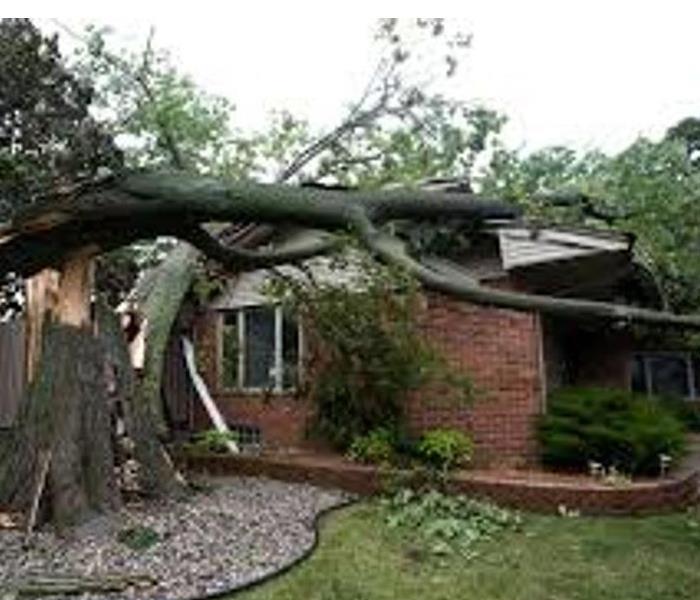 Protect Your Home from Storm Damage
Protect Your Home from Storm Damage
1. REPLACE MISSING OR DAMAGED SHINGLES
If a shingle is damaged, it’s more likely to break free. If it’s missing, well then you’ve got a gap for the wind to get under and do even more damage.
Note that when you’re installing or replacing shingles, they must be nailed properly — NOT above the nail line.
In terms of how roofing materials – shingles vs. metal – hold up to hail, it doesn’t really matter. After a hailstorm, our crews will end up replacing just as many shingle roofs as metal ones.
2. REPAIR LOOSE SIDING
The same rules as roofing apply to siding: it’s important to ensure your siding isn’t damaged.
3. KEEP YOUR GUTTERS CLEAR
Make sure your gutters are free-flowing and your downspouts flow away from your foundation.
Water damage or flooding is one of the quickest ways to devalue your home. So ensuring your gutters are clear is the first line of defense in helping water to flow away from your home. This leads to another important preventative measure …
4. ENSURE WATER CAN FLOW AWAY FROM YOUR HOME
The grade of your lot should keep water flowing away from your home and into a ditch, drain, or some other proper retention area.
5. KEEP YOUR SUMP PUMP IN WORKING ORDER
Before Spring rains startup, we suggest checking whether your sump pump is in working order. If you want to feel extra-secure, having a backup sump pump is a sure-fire way to prevent basement flooding.
6. ENSURE PROPER SEALING OF DOORS AND WINDOWS
Wind only needs a small opening to get underneath something like shingle or siding and rip it off. And in the event of tornadic winds, a small opening in your windows or doors could enlarge (read: break) and allow enough wind inside to compromise your home’s roof.
7. CHECK FOR LOOSE FENCE POSTS
Wind will surprise you. Anything that’s not nailed down is a liability, and that includes fence posts, which are often forgotten or ignored in homeowner’s storm-prep.
Checking your fence’s footing is as easy as giving each post a strong shake to check for loose ones.
8. REGULARLY TRIM YOUR TREES
Problem tree limbs can damage your home, a vehicle, or even your neighbor’s property. Regularly trimming the trees on your property is an excellent way to protect your roof and windows.
9. WALK AROUND YOUR PROPERTY
A lot of people don’t have the time or skills to check and/or repair everything on their property before storm season kicks up. But, if you know a storm is coming, there are some very basic steps you can take to minimize its impact.
Like identifying the items around your property that could become projectiles. That means lawn furniture, tools, flower pots, or other yard debris. Do yourself a favor and move those items to a garage, a shed, or indoors.
10. KEEP A GENERATOR ON HAND
A bad storm could potentially knock out power to your home for a couple of hours — or days. Having a generator on standby could go a long way towards ensuring you don’t lose your food, or the livability of your home until power is restored.
Steps to Take Immediately After a Storm Damage
9/11/2020 (Permalink)
 When the storm hits, know what to do
When the storm hits, know what to do
Storm damage can occur at any time and can cause an immense amount of harm to your home. Heavy rains can cause flooding and powerful winds can cause roof damage and downed trees on your property. Some post-storm damage can create safety and health hazards as well, so having a strategy to deal with damage will help you to be ready to take steps immediately after the storm.
Take Safety Precautions
Heavy winds and rain can create physical hazards such as collapsed roofing materials, window damage, collapsed walls, or standing water in the basement or home interior. In addition, moisture can soak into furniture, carpeting, and building materials making the perfect environment for mold growth that can cause health effects. Shut off the main gas line if you smell gas. Beware of broken glass, exposed nails, and other sharp objects on the property. Contact SERVPRO of Kendall County tohelp do basic tasks to secure your property and make it safe to use. If necessary, arrange for an alternative place for you and your family to live while your property is being restored to safe living conditions.
Photograph the Damage
If it is safe to move around your property, use your cellphone or a camera to photograph the damage so that you will have a record for your insurance company. This action will ensure that you are fully compensated.
Contact Your Insurance Company
Contact your insurance agent to notify them about the damage to your home immediately. The company will send out an adjuster to determine the extent of the damage so that payment for repairs can be made.
Ways to Protect Your Property from a Storm Surge
9/11/2020 (Permalink)
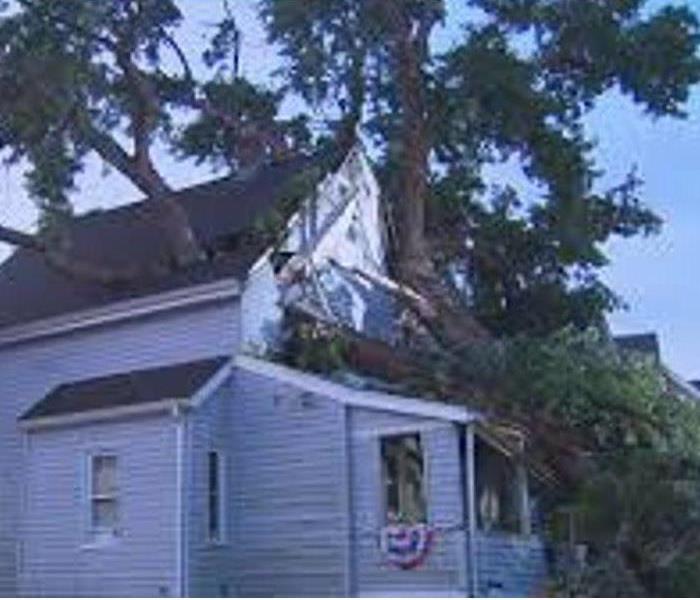 Protect your home from storms that produce high winds
Protect your home from storms that produce high winds
Storms can cause heavy rain and power breakouts, which causes many more problems for homeowners. Hence, residents of Kendall County must know the necessary tips to prevent storm damage to their homes.
If proper precautions are not taken when necessary, the damage done by these natural disasters can be devastating. So, instead of ignoring the signs, it’s better to take the right preventive measures beforehand.
Here are a few tips you can follow to protect your property from a storm surge.
• Trim Your Trees
Storm damage prevention doesn’t just mean that you need to secure your house. You also need to make sure that others don’t get hurt because of the trees on your property. Those tall, beautiful trees might add to the aesthetics of your house but stormy winds can make them a danger for everyone. So, make sure you trim them so that they don’t hurt anyone.
• Keep a Standby Power Source
High winds can disrupt the power lines of your area, and a heavy storm can even blow up the transformers. This is why you need to have a standby power system in your home as a backup. You can either buy a home generator or a power inverter device to keep the power on in the event of power outages.
• Pack Up All Your Outdoor Decorations and Furniture
Your chairs, tables, and couches might look great on your porch but during a storm, all these things can be hazardous for your property. Your outdoor furniture items can wreak havoc if they get picked up by high winds. Therefore, it is essential to pack away all your outdoor decorations to prevent your property from damage.
• Install Storm Shutters
You need to protect your house windows as soon as possible. This is because the turbulent winds of a storm can damage your windows quickly. Therefore, you need to install storm shutters on your windows to prevent them from shattering.
We hope these tips will help you prevent your house from storm damage.
Know What To Do After the Storm
8/31/2020 (Permalink)
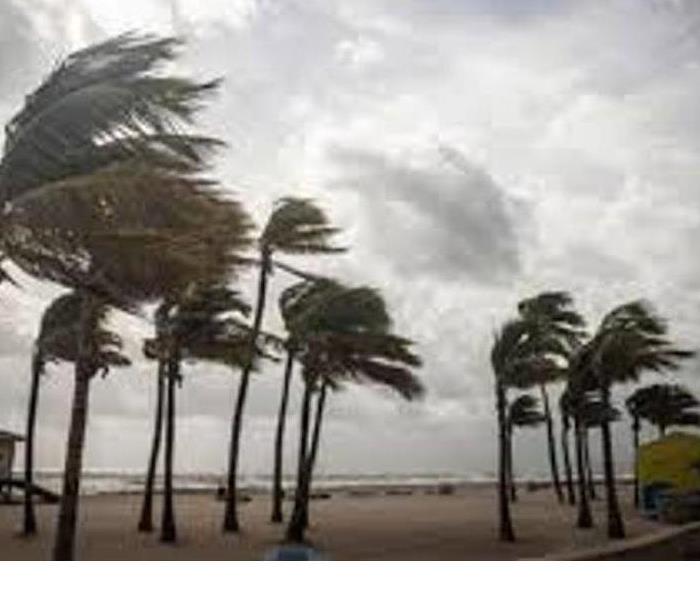 Be prepared after the storm hits
Be prepared after the storm hits
Storm damage can occur at any time and can cause a lot of harm to your home. Heavy rains can cause flooding and powerful winds can cause roof damage and downed trees on your property. Some post-storm damage can create safety and health hazards as well, so having a strategy to deal with damage will help you to be ready to take steps immediately after the storm.
Take Safety Precautions
Heavy winds and rain can create physical hazards such as collapsed roofing materials, window damage, collapsed walls, or standing water in the basement or home interior. In addition, moisture can soak into furniture, carpeting, and building materials making the perfect environment for mold growth that can cause health effects. Shut off the main gas line if you smell gas. Beware of broken glass, exposed nails, and other sharp objects on the property. Contact SERVPRO of Kendall County to help do basic tasks to secure your property and make it safe to use. If necessary, arrange for an alternative place for you and your family to live while your property is being restored to safe living conditions.
Photograph the Damage
If it is safe to move around your property, use your cellphone or a camera to photograph the damage so that you will have a record for your insurance company. This action will ensure that you are fully compensated.
Contact Your Insurance Company
Contact your insurance agent to notify them about the damage to your home immediately. The company will send out an adjuster to determine the extent of the damage so that payment for repairs can be made.
Look Into Federal Disaster Assistance
The federal government may have declared the area affected by the storm as a disaster area that is eligible for low-cost loans to help restore your property to normal. You will be required to file documents to receive these loans.
When a storm-related disaster strikes, it may seem overwhelming, but these steps can help you to begin the process of restoring your home, and your life, to normal. At SERVPRO of Kendall County, we provide 24-hour emergency disaster service. We specialize in the stabilization and restoration of homes and businesses that have suffered a small or large loss from water, flood, wind, storm, fire damage, and smoke disaster.
THUNDERSTORM SAFETY
8/11/2020 (Permalink)
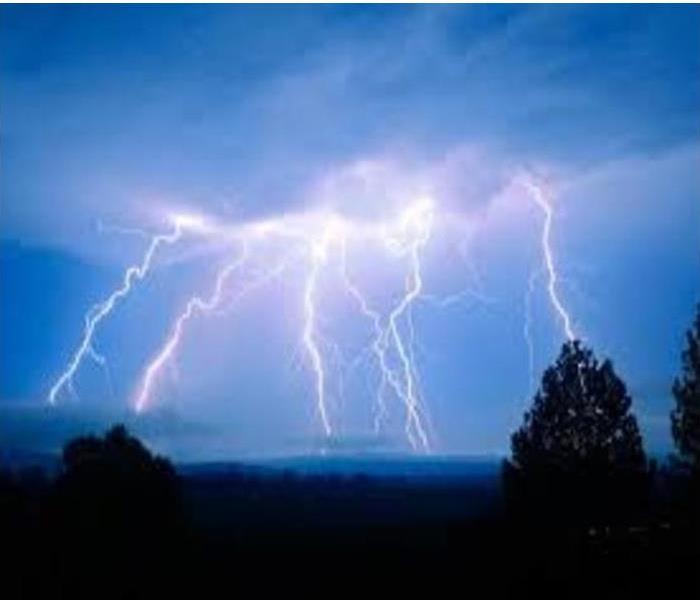 Be prepared. Know what to do before a major storm hits.
Be prepared. Know what to do before a major storm hits.
All thunderstorms produce lightning and are dangerous. If you hear the sound of thunder, then you are in danger from lightning. Lightning kills between 75 to 100 people each year and being outdoors in the most dangerous place to be. Always listen to the radio and television for the latest information and instructions for your area.
A THUNDERSTORM WATCH means a thunderstorm is possible for your area.
A THUNDERSTORM WARNING means a thunderstorm is taking place in your area.
IF YOU’RE OUTDOORS:
- Keep an eye at the sky. Look for darkening skies, flashes of lightning, or increasing winds. Lightning often proceeds rain, so don’t wait for the rain to begin. If you hear the sound of thunder, go to a safe place immediately.
- The best place to go is a sturdy building or a car, but make sure the windows in the car are shut. Avoid sheds, picnic areas, baseball dugouts and bleachers.
- If there is no shelter around you, stay away from trees. Crouch down in the open area, keeping twice as far away from a tree as far as it is tall. Put your feet together and place your hands over your ears to minimize hearing damage from thunder.
- If you’re with a group of people stay about 15 feet from each other.
- Stay out of water. It’s a great conductor of electricity. Swimming, wading, snorkeling and scuba diving are not safe. Also, don’t stand in puddles.
- Avoid metal. Stay away from clotheslines, fences, and drop your backpacks because they often have metal on them.
- If you’re playing an outdoor activity, wait at least 30 minutes after the last observed lightning strike or thunder.
IF YOU’RE INDOORS:
- Avoid water. It’s a great conductor of electricity, so do not take a shower, wash your hands, wash dishes or do laundry.
- Do not use a corded telephone. Lightning may strike exterior phone lines.
- Do not use electric equipment like computers and appliances during a storm.
- Stay away from windows and doors, and stay off porches.
IF SOMEONE IS STRUCK BY LIGHTNING:
- Call for help. Call 9-1-1 or send for help immediately.
- The injured person does not carry an electrical charge, so it is okay to touch them.
Storm Damage Restoration
8/5/2020 (Permalink)
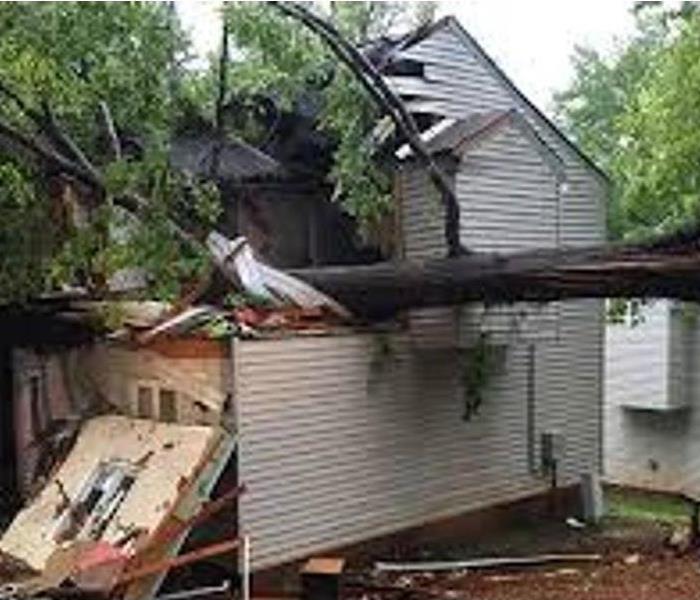 Stroms Can Hit at Any Time, SERVPRO od Kendall County is Ready Are You?
Stroms Can Hit at Any Time, SERVPRO od Kendall County is Ready Are You?
Every area of the country experiences severe weather from time to time and the more severe the storm is, the more likely it is to cause property damage. Thunderstorms, floods, strong winds, and snowstorms have all been known to cause significant property damage and if your home or building is damaged due to severe weather, it is crucial to react as soon as possible and secure the building.
Sometimes storms can form very quickly, leaving homeowners little time to prepare. It is wise for homeowners to always be prepared for the possibility of a storm to limit the damages if one does occur unexpectedly.
Severe storms can cause all types of property damage including water damage, mold growth, structural damage, and exterior damage to the windows, siding, and roof. The technicians of SERVPRO of Kendall County have the training and equipment to repair structural damage to your home and remove debris including tree branches, broken glass, and other building materials.
Storm Damage in Oswego Illinois? SERVPRO Can Help!
7/27/2020 (Permalink)
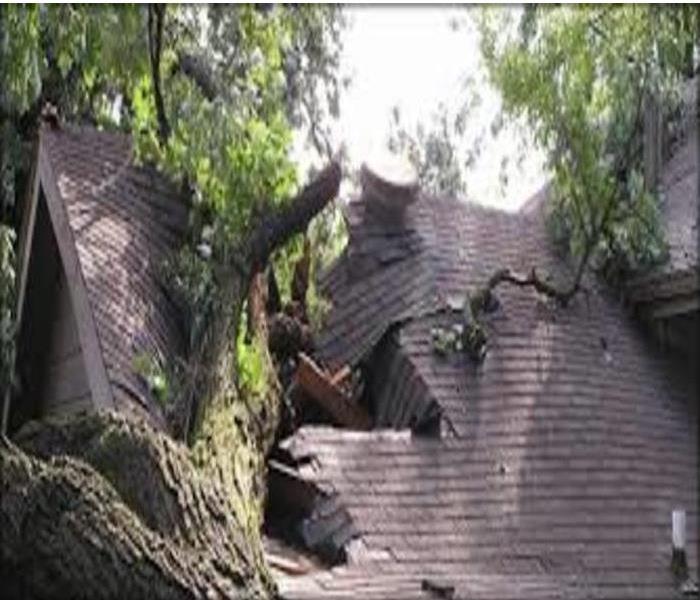 When Storm Damage Hits SERVPRO of Kendall County is here for you.
When Storm Damage Hits SERVPRO of Kendall County is here for you.
Weather damage from natural disasters, such as floods, hurricanes, and winter storms, can have overwhelming effects on your home and your family. Many times, water causes the most damage by entering your home through damaged rooftops or broken windows. Once inside, water can ruin everything from furniture, electronics and appliances to essential documents and keepsakes, saturating the structural elements of your home and putting it at risk for even greater danger.
At SERVPRO of Kendall County, we are committed to getting you back on track after severe weather damage. Open dialog is central to our customer-care approach. We keep you informed at every step of our process, to ensure that you’re always aware of the progress we’re making and to provide helpful guidance in your time of need. Whenever you need us, we’re there for you.
As a national company with local experts in your community, we’re more than highly qualified restoration professionals. We’re your neighbors dedicated to helping you and your family.
- We move quickly to minimize impact.
- We care for your most immediate needs of food, clothing and shelter.
- We develop a customized plan to bring your home back to its full preloss condition.
- Our mobilization capabilities mean we can get the services you need to your home, fast.
We will be by your side every step of the way to ensure your home and belongings are restored as quickly and safely as possible after any major weather disaster.
Tips for Homeonwers
8/16/2019 (Permalink)
Gutters can play a key role in preventing water damage to your home. That is why it is essential that you keep your gutters clean and free of debris. Their many purposes are to channel rainwater to the downspouts and away from the home, protecting roofs, walls, and foundations of homes. To keep gutters working properly, it is important to make sure that gutters are cleaned regularly so that water can flow freely to the downspouts and away from your home.
So how often should you clean your gutters? It is recommended that you clean your gutters minimum of twice a year!
Clogged gutters can cause many issues for a homeowner. If water finds its way into the walls and ceilings of the home, it will cause interior damage. In winter months, pooling water around the foundation of the home can cause foundation cracks if it freezes and expands. The paint and siding of a home can also be damaged as water overflows from the gutters.
Failing to clean gutters regularly can be a very costly mistake! It is one of the most important tasks of a homeowner and, if done on a regular basis, can prevent many homeowner headaches!
If water damage impacts your home or commercial facility, please call SERVPRO of Kendall County at 630-554-2280.
SERVPRO of Kendall County is Ready for When Storms Hit
5/18/2018 (Permalink)
SERVPRO of Kendall County has experience restoring homes affected by storms and flooding. We can respond immediately with highly trained technicians who employ specialized equipment and techniques to restore your home or business back to pre-storm condition as quickly as possible.
Faster Response
Since we are locally owned and operated, we are able to respond quicker with the right resources, which is extremely important. A fast response lessens the damage, limits further damage, and reduces the restoration cost.
Resources to Handle Floods and Storms
When storms hit Oswego area, we can scale our resources to handle a large storm or flooding disaster. We can access equipment and personnel from a network of 1,650 Franchises across the country and elite disaster recovery teams that are strategically located throughout the United States.
Have Storm or Flood Damage? Call Us Today (630) 554-2280.
Damaging Winds
5/11/2018 (Permalink)
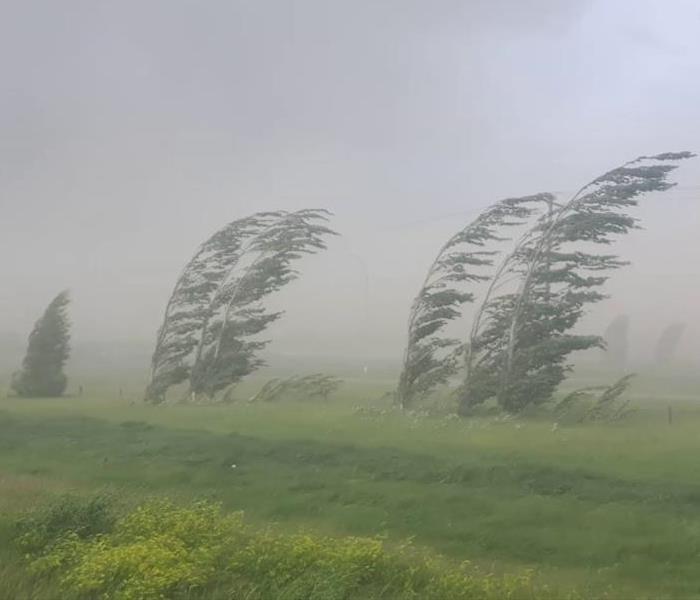
- Straight-line wind is a term used to define any thunderstorm wind that is not associated with rotation, and is used mainly to differentiate from tornado winds.
- Downdraft is a small-scale column of air that rapidly sinks toward the ground.
- Down burst is a result of a strong downdraft. A down burst is a strong downdraft with horizontal dimensions larger than 4 km (2.5 mi) resulting in an outward burst of damaging winds on or near the ground. (Imagine the way water comes out of a faucet and hits the bottom of the sink.) Down burst winds may begin as a micro burst and spread out over a wider area, sometimes producing damage similar to a strong tornado. Although usually associated with thunderstorms, down bursts can occur with showers too weak to produce thunder.
- Microburst is a small concentrated down burst that produces an outward burst of damaging winds at the surface. Micro bursts are generally small (less than 4 km across) and short-lived, lasting only 5-10 minutes, with maximum wind speeds up to 168 mph. There are two kinds of micro bursts: wet and dry. A wet micro burst is accompanied by heavy precipitation at the surface. Dry micro bursts, common in places like the high plains and the inter-mountain west, occur with little or no precipitation reaching the ground.
- Gust front is the leading edge of rain-cooled air that clashes with warmer thunderstorm inflow. Gust fronts are characterized by a wind shift, temperature drop, and gusty winds out ahead of a thunderstorm. Sometimes the winds push up air above them, forming a shelf cloud or detached roll cloud.
- Derecho is a widespread, long-lived wind storm that is associated with a band of rapidly moving showers or thunderstorms. A typical derecho consists of numerous micro bursts, down bursts, and down burst clusters. By definition, if the wind damage swath extends more than 240 miles (about 400 kilometers) and includes wind gusts of at least 58 mph (93 km/h) or greater along most of its length, then the event may be classified as a derecho.
Storm Damgage Tips
5/9/2018 (Permalink)
Water Damage Breakdown
Within Minutes
- Water quickly spreads throughout your property, saturating everything in its path.
- Water is absorbed into walls, floors, upholstery, and belongings.
- Furniture finishes may bleed, causing permanent staining on carpets.
- Photographs, books, and other paper goods start to swell and warp.
Hours 1 - 24:
- Drywall begins to swell and break down.
- Metal surfaces begin to tarnish.
- Furniture begins to swell and crack.
- Dyes and inks from cloth and paper goods spread and stain.
- A musty odor appears.
48 Hours to 1 Week:
- Mold and mildew may grow and spread.
- Doors, windows, and studs swell and warp.
- Metal begins to rust and corrode.
- Furniture warps and shows signs of mold.
- Paint begins to blister.
- Wood flooring swells and warps.
- Serious biohazard contamination is possible.
More Than 1 Week:
- Restoration time and cost increase dramatically; replacing contaminated materials and structural rebuilding may be extensive.
- Structural safety, mold growth, and biohazard contaminants pose serious risks to occupants.
Winter Storm Damage to Oswego Roof
5/7/2018 (Permalink)
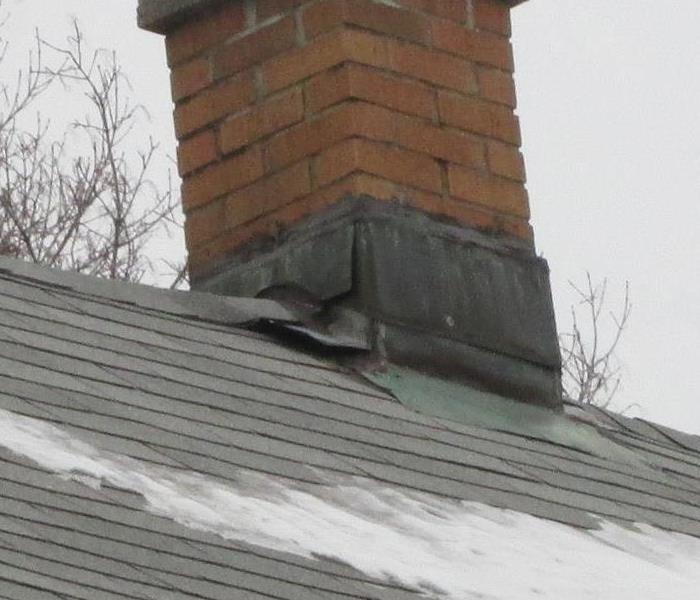 Wind Damage to Oswego Home
Wind Damage to Oswego Home
Residential Services
Whether your Oswego home needs emergency flood damage or roof tarping , you can depend on us. Our technicians have extensive cleaning and restoration training and can make your property look its best. Learn more about our residential services:
- Building/Reconstruction Services
Commercial Services
There's never a good time for fire or Water damage to strike your Oswego commercial property. Every hour spent cleaning up is an hour of lost revenue and productivity. So when the need arises for professional cleaning or emergency restoration services SERVPRO of Kendall County has the training and expertise to respond promptly with highly trained technicians to get your property back to business. Learn more about our commercial services.
We provide immediate service day or night!
When Storms or Floods hit Kendall County & Streamwood, Bartlett and West Chicago , SERVPRO is ready!
6/22/2016 (Permalink)
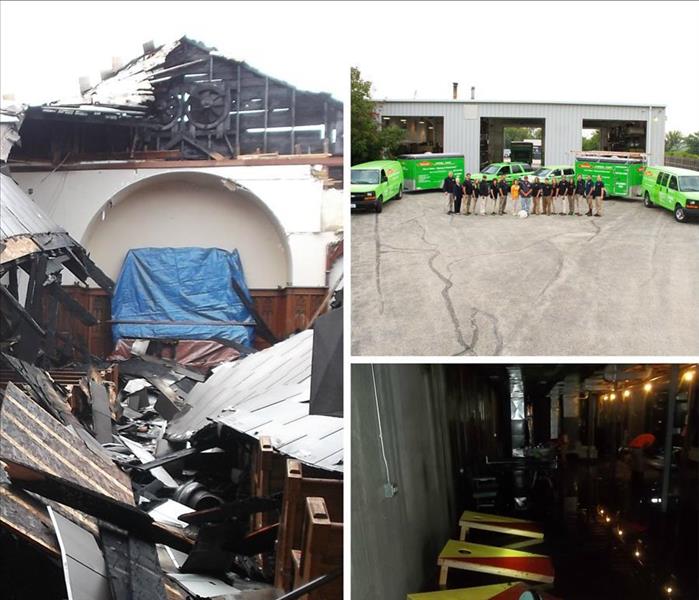 Our highly trained crews are ready to respond 24/7 to storm or flood damage in Kendall County & Streamwood, Bartlett and West Chicago .
Our highly trained crews are ready to respond 24/7 to storm or flood damage in Kendall County & Streamwood, Bartlett and West Chicago .
SERVPRO of Kendall County & Streamwood, Bartlett and West Chicago specializes in storm and flood damage restoration. Our crews are highly trained and we use specialized equipment to restore your property to its pre-storm condition.
Faster Response
Since we are locally owned and operated, we are able to respond quicker with the right resources, which is extremely important. A fast response lessens the damage, limits further damage, and reduces the restoration cost.
Resources to Handle Floods and Storms
When storms hit Kendall County & Streamwood, Bartlett and West Chicago, we can scale our resources to handle a large storm or flooding disaster. We can access equipment and personnel from a network of 1,650 Franchises across the country and elite Disaster Recovery Teams that are strategically located throughout the United States.
Have Storm or Flood Damage? Call Us Today
Kendall County 630-554-2280
Streamwood, Bartlett and West Chicago 630-562-9212





 24/7 Emergency Service
24/7 Emergency Service
